






OCTOBER 15, 2025
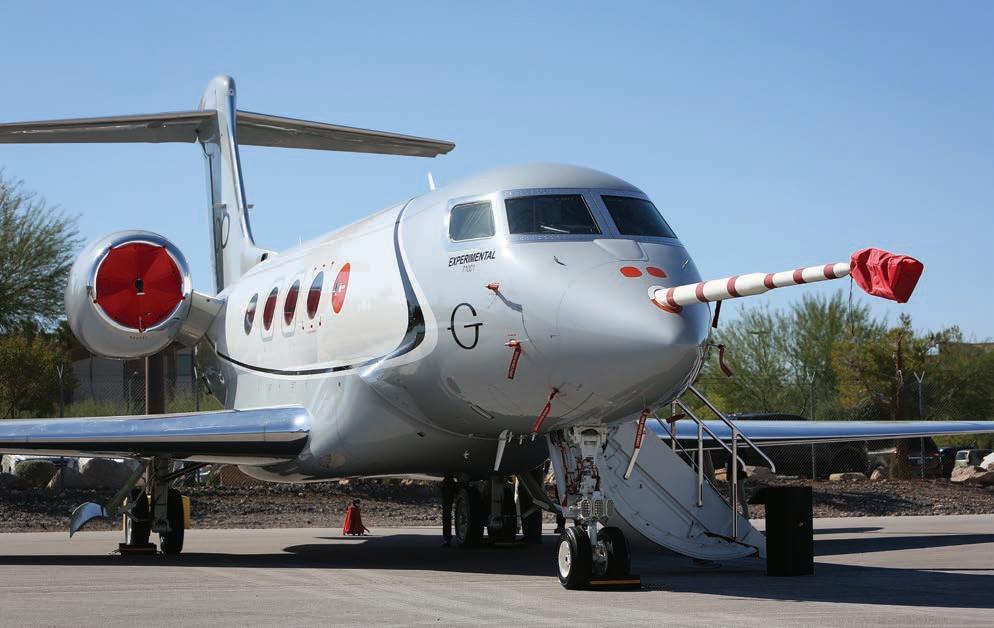
Gulfstream’s G400 is making its NBAABACE debut here in Las Vegas. The smallest in the company’s large-cabin-jet family, the G400 offers 4,200-nm range and seating for up to 12 passengers.
AINONLINE . COM
By Kerry Lynch
U.S. startup company Bond revealed plans yesterday to launch a fractional ownership operation with a fleet of Bombardier Challenger 3500s and Global 6500s under a previously announced $1.7 billion, 50-aircraft order. Including options for up to 70 more—potentially also including Global 8000s— that could push the total value to $4 billion, the order was originally disclosed in June, but Bombardier did not reveal the customer at that time. Bond plans to start service in 2027.
The deal includes a service agreement under which Bombardier’s U.S. service network will support the aircraft and provide onsite maintenance resources dedicated to the Bond fleet. “This agreement goes beyond an aircraft order. It marks a first-of-a-kind, uniquely integrated service’s
collaboration,” said Bombardier president and CEO Éric Martel.
The launch is backed by $320 million in preferred equity and debt financing led by credit funds and accounts managed by global investment firm KKR, with $30 million in equity funding from a group of founding partners. Bond announced the closing of the financing as well yesterday afternoon at the NBAA-BACE static display at Henderson Executive Airport.
Led by chairman and group CEO Bill Papariella, the former CEO of Jet Edge and founder of Aero Ventures, Bond will target “premium private flyers who value exclusivity over scale,” the company said in detailing its plans.
Calling the service “Fractional 2.0,” Bond said the operation will have the first 100% super-midsize and large-cabin fractional fleet, creating a category around long-range travel. continues on page 46
VIP UPGRADES
Magnifica Air’s fleet
Six Airbus A220s and a pair of A321s will receive VIP cabins, courtesy of Comlux | 08
OLD-SCHOOL JET
36th Lear at static
The only flyable Lear Jet 23 that is fitted with a hushkit is on display in Las Vegas | 12
RUNWAY SAFETY
Demos in Kansas City Honeywell demonstrates Surface Alerts with Boeing 757 testbed | 14
EUROPEAN BIZAV
What’s new for EBACE
The show will return to Geneva in 2026 but moves to various EU cities in odd years | 22

By Amy Wilder
MD Onboard is expanding its role in aviation health innovation through two technology partnerships with CardioSecur, a German-based developer of advanced mobile ECG technology, and HPE Innovation, a U.S. company specializing in artificial intelligencedriven biometric monitoring.
CardioSecur allows for real-time cardiac monitoring and transmitting “clinical-grade 12-lead ECG readings” to MD Onboard’s Command Center for immediate review.
“Our partnership with CardioSecur represents a major leap forward in the advancement of aviation healthcare,” said MD Onboard chief growth officer Wehda El Aridi. “By combining our aviation-specific
medical expertise with CardioSecur’s revolutionary ECG technology, we are enhancing our ability to diagnose and manage in-flight medical events with greater speed, accuracy, and confidence.”
CardioSecur CEO Felix Brand noted that the joint approach provides access to advanced diagnostics and expert advisory at altitude. “Our technology merges high-tech diagnostics with unparalleled ease of use— helping reduce unnecessary diversions and increasing safety for every flight,” he said.
Meanwhile, MD Onboard has also partnered with HPE Innovation to integrate touchless, AI-driven biometric tracking into its mobile platform. The technology uses camera sensors to measure heart rate, breathing rate, blood pressure, and oxygen saturation
Universal Avionics has selected FreeFlight Systems’ dual-band ADS-B solution for integration with its Conn ected Avionics ecosystem and InSight Flight Deck, the companies announced yesterday at NBAA-BACE 2025. The partnership combines cockpit connec tivity, situational awareness capabilities, and operational e ciency tools for business aviation and rotorcraft operators.

ADS-B will be integrated with its Connected Avionics ecosystem and InSight Flight Deck.
Aircraft equipped with Universal Avionics’ WAAS-enabled FMS can now access the FlightPartner Connected FMS app, which provides situational awareness and flight planning capabilities using ADS-B In tra c and weather data. The system augments InSight Flight Deck features, including embedded synthetic vision, advanced mapping, and electronic charts displayed on glass cockpit screens.
“We’re merging not just ADS-B In targets, but TCAS targets as well to give the pilot a comprehensive view of all aircraft around,” Anthony Rios, president of FreeFlight Systems, told AIN J.R.

with medical-grade accuracy. “Integrating HPE Innovation’s non-contact, AI-driven biometrics into our app represents the future of proactive crew and passenger health,” said MD Onboard CEO Grant Jeffery.
The system allows operators to conduct preflight wellness screening, continuous in-flight monitoring, and postflight assessments without additional hardware. “We’re proud to support safer skies through accessible and accurate biometric intelligence,” said HPE Innovation founder and CEO Nicholas Harris. z
Universal Aviation—which will soon be separated from its parent company Universal Weather and Aviation following the latter’s sale to World Kinect—is in the midst of the most aggressive infrastructure developments in the company’s 66year history. With more than 50 locations in 30 countries, it is continuing to expand to meet the rising demand for business aviation services.
Ahead of next year’s FIFA World Cup, Universal’s new FBO at Mexico’s Guadalajara International Airport (MMGL), the third-busiest airport in the country, is slated to open in March.It will feature a 22,000-sq-ft double-height terminal with private lounges, in-house customs, pilot lounge, and porte-cochère, along with 177 secure vehicle parking spaces and electric charging stations.
At Madrid–Barajas Airport (LEMD), the company is building Spain’s first dedicated general aviation hangar—a nearly 54,000-sq-ft structure also capable of handling narrowbody bizliners.
In the Dominican Republic, Universal’s FBO partnership at Prof. Juan Bosch International Airport (MDCY) is nearing completion, with the remodeled facility scheduled to open by year-end. Meanwhile in Saudi Arabia, the company just announced an agreement that will see its entrance into the Middle East. C.E.


By Amy Wilder
The 2025 NBAA-BACE keynote session opened with a clear message from NBAA president and CEO Ed Bolen: Safety is aviation’s enduring foundation. “We have a core value. We have a number-one priority, and that is safety—safety first, safety always,” he told the audience in Las Vegas.
Reflecting on a series of early-2025 accidents—including the January 29 midair collision over the Potomac River and other fatal crashes—Bolen said the events rocked the industry and demanded a renewed commitment. “We’ve got to do better. We’ve got to do it right now,” he said.
The industry’s collective response, he added, has been marked by self-examination and unity. “Business aviation and all of aviation did what it does—we came together,” he said, noting that this renewed focus on safety has also strengthened alignment on building a new air traffic control system supported by
airlines, airports, labor, and government leaders across political lines.
Bolen framed the safety mission within the larger purpose of aviation as an economic and human connector. “We are a powerful engine for the U.S. economy,” he said. “We create jobs, we provide economic development, and we help companies be efficient and productive in an intensely competitive marketplace.”
That message carried through his conversation with this year’s Meritorious Service to Aviation award recipient: Steuart Walton. The co-founder of Game Composites and a longtime advocate for aviation access and innovation, Walton spoke about the importance of community as the true foundation for growth. “Aviation is an unparalleled platform to provide inspiration,” he said. “The more people that come into it, the stronger it gets.”
Walton described his work developing Bentonville, Arkansas’ Thaden Fieldhouse and the Fly Oz backcountry network as part
of an effort to make aviation accessible to people from all backgrounds. “Whether you’re a pilot or not, whether you’re into aviation or just curious, it’s kind of a starting point for all kinds of different journeys,” h e said.
Bolen agreed, emphasizing that aviation’s strength lies in its people and its shared mission. “At the end of the day, business aviation, in addition to connecting places, connects people,” the NBAA leader said.
Bolen also underscored how the aviation community’s response to tragedy consistently reinforces its unity. “We looked at root causes, we looked at promoting a just culture, and we looked at how we could make sure we were even safer tomorrow than we are today,” he said. “That’s what makes our community strong.”
Closing the keynote, country music artist and pilot Dierks Bentley brought humor and reflection to the stage, blending stories from his music career and flying life. Bentley recalled driving his daughter to school years ago, frustrated about a day spent “trying to rhyme words with whiskey and truck.” The moment when she asked him, “Do you got to, or do you get to?” reshaped his outlook. “Every time I step in a plane,” he said, “it’s not a ‘got to,’ it’s a ‘get to.’”
Later, Bentley returned to that theme, connecting it to aviation’s deeper meaning. “When people ask what aviation means to me,” he said, “it just all goes back to that morning with my daughter…I get to fly, I get to chase dreams, and then I get to come home.”
“I get to do this because of all the people who keep business aviation alive and thriving,” he continued. “Aviation isn’t just transportation. It’s possibility. It’s the path that connects our work with our families, our passions to our purpose, and when we do it right, we stay grateful. The sky stops being the limit. It becomes the pathway.”
After a pause to let the audience absorb this, his puckish side returned. “Okay, I didn’t write that,” he announced, drawing laughter from the audience. “That’s all ChatGPT…I love that alliteration. All those P sounds—P P P. Passions, purpose, pathway. NBAA 2026. Ed, you’re welcome to use that.” z


By Charles Alcock
Business aviation services group Comlux is joining forces with U.S. start-up airline Magnifica Air to outfit six Airbus A220s and a pair of A321s with VIP cabins. Announcing the partnership on Tuesday at NBAA-BACE 2025, Magnifica Air said it will deploy the narrowbodies for what it calls a “private-jet-meetsfirst-class” scheduled commercial service.
Comlux America’s Indianapolis facility will handle the full cabin completion for the A220s and the A321s. Magnifica will then integrate the aircraft into its VIP operation, which it said will use private terminals at as-yet-unspecified “exclusive” airports.
As a partner in Airbus’ ACJ TwoTwenty program, Comlux already has experience in equipping green examples of the modified A220, which was originally developed by Bombardier as the CSeries. Active in aircraft management and charter in Europe, the group has also completed and modified multiple other Airbus and Boeing narrowbodies.
“This deal not only strengthens Comlux’s existing backlog of completions projects, but it validates the strategic positioning and transition we have been undergoing over the past few years,” said Adam White, CEO of Comlux America. “In addition to the 17 exclusive cabins on the ACJ TwoTwenty, it
demands the same consistent, reliable, quality interiors inside the newest commercially viable airframes expanding all of the benefits of private charter, or ownership, to a wider customer base.”
Florida-based Magnifica Air plans to launch services in 2027 and is leasing the A220-300s and A321neos from Air Lease Corp. Each aircraft will carry between 45 and 54 passengers, with cabins featuring between two and four private suites.
Innovative Solutions & Support has rebranded as Innovative Aerosystems, marking a new era for the Exton, Pennsylvania-based avionics manufacturer. The refreshed identity unveiled this week at NBAA-BACE 2025 includes a revamped web presence and the announcement of a new avionics suite. It reflects what CEO Shahram Askarpour called the company’s next step toward intelligent integration.
The first product under the new banner is the Liberty Flight Deck, an open-architecture avionics suite featuring the company’s patented “Utility Management System.” Liberty


Initially, the new airline plans to operate six or seven daily departures connecting Miami, New York, Los Angeles, San Jose, Palm Beach, Dallas, and Houston, with some seasonal routes to Napa Valley and the Caribbean. It may also offer charter flights and “curated experience trips” to events like Art Basel and Formula 1 races.
“In aviation, what people remember most is how you made them feel,” said Wade Black, CEO of Magnifica Air. “That’s why we’ve chosen to partner with Comlux—the best in the business when it comes to exceptional outfitting. This partnership represents a global handshake grounded in our shared dedication to craftsmanship and excellence.” z
integrates large-format touch displays, dual flight management systems, synthetic vision, autothrottle, and mission system capabilities.
“Liberty represents the convergence of innovation and practicality,” Askarpour added. “It’s built for tomorrow’s missions across commercial, business, and defense aviation— free from proprietary limitations and supplier lock-down.”
For more than 35 years, the company has specialized in air data and cockpit avionics. The refreshed brand underscores its expanded focus on advanced, integrated systems designed to enhance aircraft performance, safety, and e ciency.
Innovative Aerosystems said its core values remain unchanged, emphasizing continued support for existing customers and long-term reliability across its avionics portfolio. A.W.
Set your technicians up for success with professional training from the industry leader. FlightSafety International’s factory-trained instructors utilize immersive tools, like virtual engines and part-task trainers, for hands-on instruction. Maintenance professionals develop critical troubleshooting skills and know precisely how to service aircraft quickly and accurately.

Learn about our comprehensive training solutions at NBAA-BACE booth 1545.

Visit us at NBAA Booth #1533
By Matt Thurber
The only Lear Jet 23 that is flyable and fitted with a hushkit that allows for normal flight operations is at the NBAA-BACE static display’s “Tribute to Flight” pavilion, but possibly just for a limited time through Wednesday. Owned by Jim Donovan, this rare airplane is going up for auction at a Mecum Auctions event next month.
At every turn, Donovan’s experience with this particular airplane—N477K—has turned up a slew of historical coincidences. The latest was how famed Lear pilot and aviator Clay Lacy arrived in Las Vegas for NBAA-BACE 2025. Donovan flew from his base in the Sacramento, California area to Van Nuys to pick up Lacy and fly him to Henderson Executive Airport, which is hosting the NBAA static display this week. Lacy was Bill Lear’s first dealer and has long been involved with the high-performance aircraft— one of the first purpose-built business jets.
N477K is the 36th Lear—built in 1965. And being a Model 23, it suffers from a challenge facing all early Lears powered by GE’s legendary but noisy CJ610 turbojet engine: it can’t be flown legally without a hushkit. Avcon developed a hushkit for Lear 24/25 models, but that STC didn’t include the Lear 23, Donovan explained.
Donovan learned to fly Lears as a charter pilot under the tutelage of Hop-A-Jet founder Harvey Hop in the 1980s. He subsequently flew air ambulances, then switched to airline
flying, from which he retired. His most recent airplane was an Aerostar 600A piston twin, and he sold that to pay for the maintenance that N477K needed after he bought it.
In fact, Donovan bought two Lear 23s—one that he didn’t plan to fly (N823LJ) and wanted to turn into a lawn art piece in front of his hangar, then acquiring N477K about five years ago. A year ago, Donovan scraped together enough money to pay for the maintenance needed to restore N477K to flying status, using parts from both airplanes. The jet was in “gorgeous condition,” he said, with a fresh interior and paint in 1999.
Luckily, the parts Learjet came with the only Stage III hushkit ever approved for a Lear 23, according to Donovan. “Somebody spent $120,000 on this hushkit back in 2008 or 2006 and did flights for BAE/Tracor, then they surrendered the STC back to the FAA. I bought a Lear with that set on it, then I bought this one, and I got permission from the FAA to move the hushkit from one to the other.”
At some point, a Garmin GNS 530 navigator was installed in N477K, and it is also equipped with Avcon RVSM and Garmin ADS-B Out and TAWS. “I would prefer it had no avionics upgrades and the original radios and navs in it,” he admitted. The Lear, which has its original N-number from the factory, has logged more than 5,524 hours to date, and each engine has about 2,000 hours remaining before overhaul is due.
After getting N477K back in the air last year, Donovan wanted to fly it around the U.S. with his wife dressed as Brigitte Bardot, to replicate
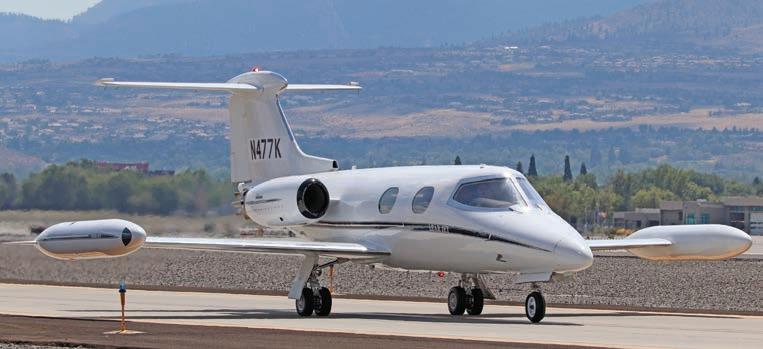

a famous photo of Bardot and her husband, Gunter Sachs, standing in front of the twinjet. She married the German playboy and industrialist on July 14, 1966.
Donovan would have dressed as Frank Sinatra and had his copilot wear Dean Martin regalia, in honor of both actors’ experiences flying in Lears. However, the cost of the trip was just too high, and he said, “My wife doesn’t fancy being in a little jet that long.”
Jim Donovan’s Lear 23 is the only one equipped with hushkits and legal to fly .
Coincidentally, at a Mecum auction in Glendale, Arizona, in March, Donovan met a “gorgeous blonde lady” who he thought would be ideal to play the Brigitte Bardot role for the trip. She turned out to be Pat Bondurant, widow of race car driver and teacher Bob Bondurant and president and CEO of Bondurant Racing School. When Donovan mentioned Brigitte Bardot, Pat explained that her husband dated Bardot in 1965 when he was in France teaching James Garner to race cars for the movie Grand Prix
In any case, that dress-up trip never left the ground, and Donovan plans to auction N477K at the November 15 Mecum auction after its appearance this week at the NBAA “Tribute to Flight.” A second lot will auction N823LJ for spare parts. “I’m not rich,” he said. “I can’t afford to fly it more than one hour every three months. I got it, I did it, I had my fun.” z

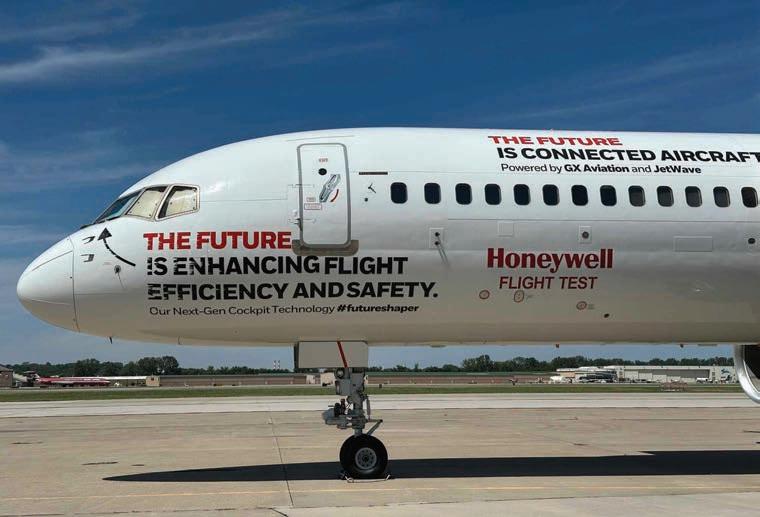
By Amy Wilder
Honeywell recently brought its Boeing 757 testbed to Kansas City to demonstrate its ground safety cockpit tech. Included in this demo were its newest runway safety addition—Surface Alerts (Surf-A)—along with its already-certified SmartRunway/SmartLanding (Smart X), which helps pilots avoid wrong-surface events and runway excursions. Both create direct cockpit alerts hosted on Honeywell Enhanced Ground Proximity Warning System (EGPWS) units.
While Smart X has been available for roughly a decade, Honeywell expects Surf-A certification on transport-category aircraft next year, pending approvals and ongoing successful flight tests and demos on the 757. Surf-A is an EGPWS-hosted software upgrade, designed to be retrofitted across a broad installed base.
During a preflight media briefing, Thea Feyereisen, senior technical fellow at Honeywell Aerospace Technologies, outlined three risk areas these technologies are built to address: wrong-surface operations, runway excursions, and runway incursions.
Smart X provides aural and visual cues such as “on taxiway,” “flaps, flaps,” “too high,” “unstable,” and “long landing.” These cues alert pilots in real time to highenergy approaches, configuration errors, and wrong-surface alignments when their attention is outside the cockpit during highworkload phases of flight.
Surf-A extends that protection to runway incursions by using ADS-B data and trajectory analysis to warn pilots when another aircraft or vehicle in the runway engagement zone creates a collision risk within roughly 30 seconds. Pilots can hear four distinct callouts: “traffic
on runway,” “traffic on final,” “traffic intersecting runway,” and “traffic behind,” with supporting text on the display.
“The NTSB has recommended direct alerts for the pilots,” Feyereisen said, emphasizing the potential time savings of bypassing controller-to-pilot radio latency in time-critical situations. Cockpit alerts can also step in to save the day when busy airspace radio traffic might mean radio calls get lost or stepped on.
During the demo flight, Honeywell recreated two high-profile close calls widely discussed in industry safety forums to show how cockpit alerting technology could give pilots more time to respond in critical moments. In February 2023 at Austin-Bergstrom International Airport, a landing FedEx Boeing 767 and a departing Southwest B737 came within seconds of collision. The testbed aircraft approached a runway surface with a Gulfstream already on the active surface; as it neared the runway, a visual and aural alert showed “traffic on runway,” and the pilots initiated a go-around. The February 2023 incident was noteworthy in that the field was obscured by fog and controllers could not see that the Boeing 737 had taxied onto the active runway.
A second scenario mirrored a January 2023 New York JFK event in which an American Airlines 777 taxied onto an active runway as a Delta 737 was taking off. During this demonstration, Honeywell’s 757 testbed began its takeoff roll on the runway, and the cooperating Gulfstream taxied across the runway in front of it. An alert in the cockpit advised pilots of the traffic intersecting the runway; the pilots had ample time to react while it was still difficult to see the crossing airplane in the distance.
Flight engineers on board Honeywell’s 757 coordinated each demonstration with the pilots of both aircraft. The pilots coordinated with air traffic control to ensure safety during the demonstration.
Honeywell also showcased Smart X’s excursion-mitigation function in which pilots approached the runway with a deliberately unstable approach: missing flaps configuration (“flaps, flaps”), approaching above the glidepath (“too high”), failing to stabilize (“unstable”), then floating beyond the aim
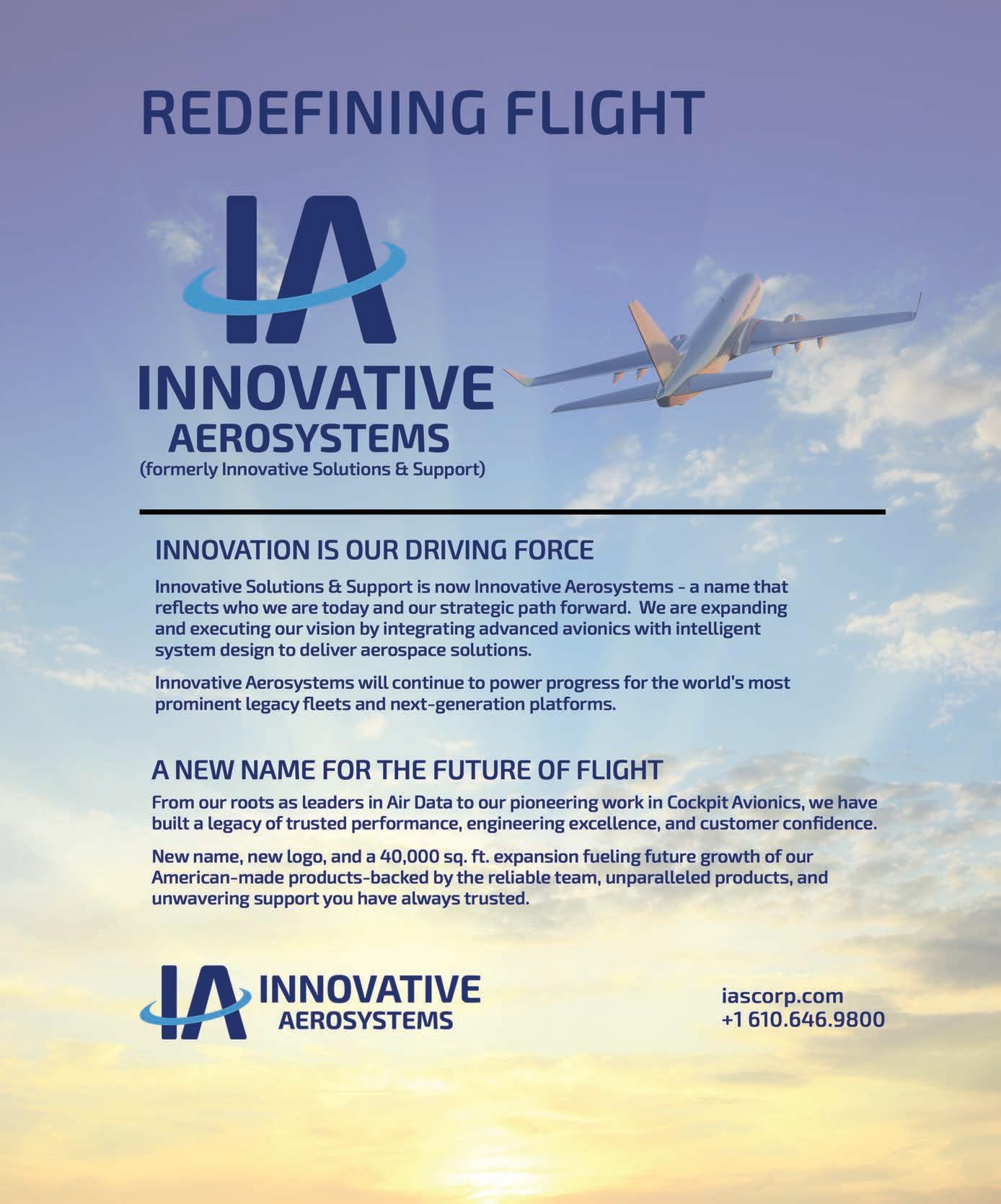
point (“long landing”), with distance-remaining callouts. Honeywell’s pilots then demonstrated a simulated taxiway-takeoff lineup, prompting an “on taxiway” alert around 40 knots groundspeed, underscoring the value of an aural prompt before brake energy or runway length becomes limiting.
On June 16, Honeywell announced that Southwest Airlines is “in the process of activating its entire Boeing 737 aircraft fleet” with SmartRunway/SmartLanding via the EGPWS already on the aircraft, with “more than 700 aircraft…activated to date.”
Feyereisen framed Surf-A as a “third set of eyes” complementing existing tower-based systems: ground-side tools can alert controllers, she said, but they do not always
warn pilots directly, and simultaneous radio transmissions can mask urgent calls. “Pilots are the last line of defense,” she said, noting Honeywell’s effort to tune Surf-A thresholds to minimize nuisance alerts while preserving early warning.
Uptake of the technologies remains shaped by regulatory, cost, and operator process considerations. Honeywell executives said that roughly 20% to 25% of commercial aircraft globally use Smart X-type capabilities—a figure consistent with Honeywell’s assertion that “about 5,000 commercial aircraft,” or roughly 20% of the fleet, have SmartRunway/SmartLanding installed. While Alaska Airlines adopted early, and Southwest is now moving fleetwide,
broader deployment will depend on airline training timelines and regulatory direction. Honeywell first previewed 30-second incursion alerts and the four-callout scheme last year on flights between Seattle and Yakima, Washington, planning 12 to 18 months to approval. Honeywell expects transport-category certification in 2026, while continuing to explore forward-fit display enhancements under the Surf-A program with OEM partners.
With global traffic growing and runway infrastructure largely fixed, layers of protection matter. Smart X aims to break the chain that leads to excursions and wrong-surface events, while Surf-A is intended to buy pilots time to avoid incursions.“Every second counts,” Feyereisen concluded. z
Flight support group Hadid International has a new U.S. operations o ce to boost services for customers in North and South America.
The company’s hub at Houston William P. Hobby Airport (KHOU) was opened earlier this year inside the Galaxy FBO terminal.
According to Moaiad Shammout, the Dubaibased group’s regional director for the Americas, its expanded presence in the U.S. allows it to get closer to customers in that market. The company already has an established sales force in the Texas city, and they are now supporting an operations team that is expected to grow.
Established in 1981, Hadid specializes in tasks such as securing overflight and landing permits, as well as arranging refueling and ground handling. It has a strong presence in markets such as the Middle East, Africa, and Asia, where there is limited support infrastructure.
As part of e orts to make its services more accessible to clients, the company has integrated the Leon software tool with its own Compass customer support portal. This is intended to make it easier for operators to access key data such as flight briefs, visa documentation, and fuel releases.
Hadid also o ers clients access to the FuelerLinx aviation fuel-planning and tankering
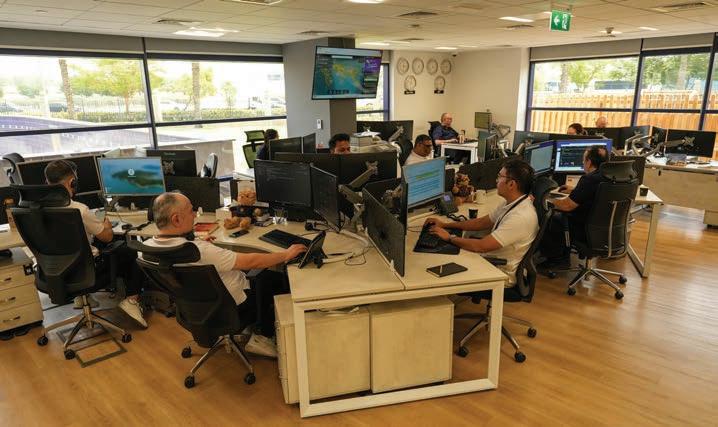
software that helps to automate the fuel supply process. Another partnership with G3 Global Services supports clients in securing visas through the company’s 62 o ces worldwide.
Shammout said Hadid is seeing increased business aircraft tra c into and within Saudi Arabia in response to growing economic opportunities in the country and across the wider Middle East region. Demand for flight support has also been increasing in India, he added. Meanwhile, the first students have begun
classes at the Intercontinental Aviation Academy GCC, which Hadid launched in February through a partnership with Intercontinental Aviation Enterprise. The college, which is located at Ras Al Khaimah International Airport (OMRK) in the United Arab Emirates, is focused on providing operational training for aviation personnel, including pilots, cabin crew, and flight-support teams. The facility includes flight simulators and Diamond DA40 training aircraft. C.A.

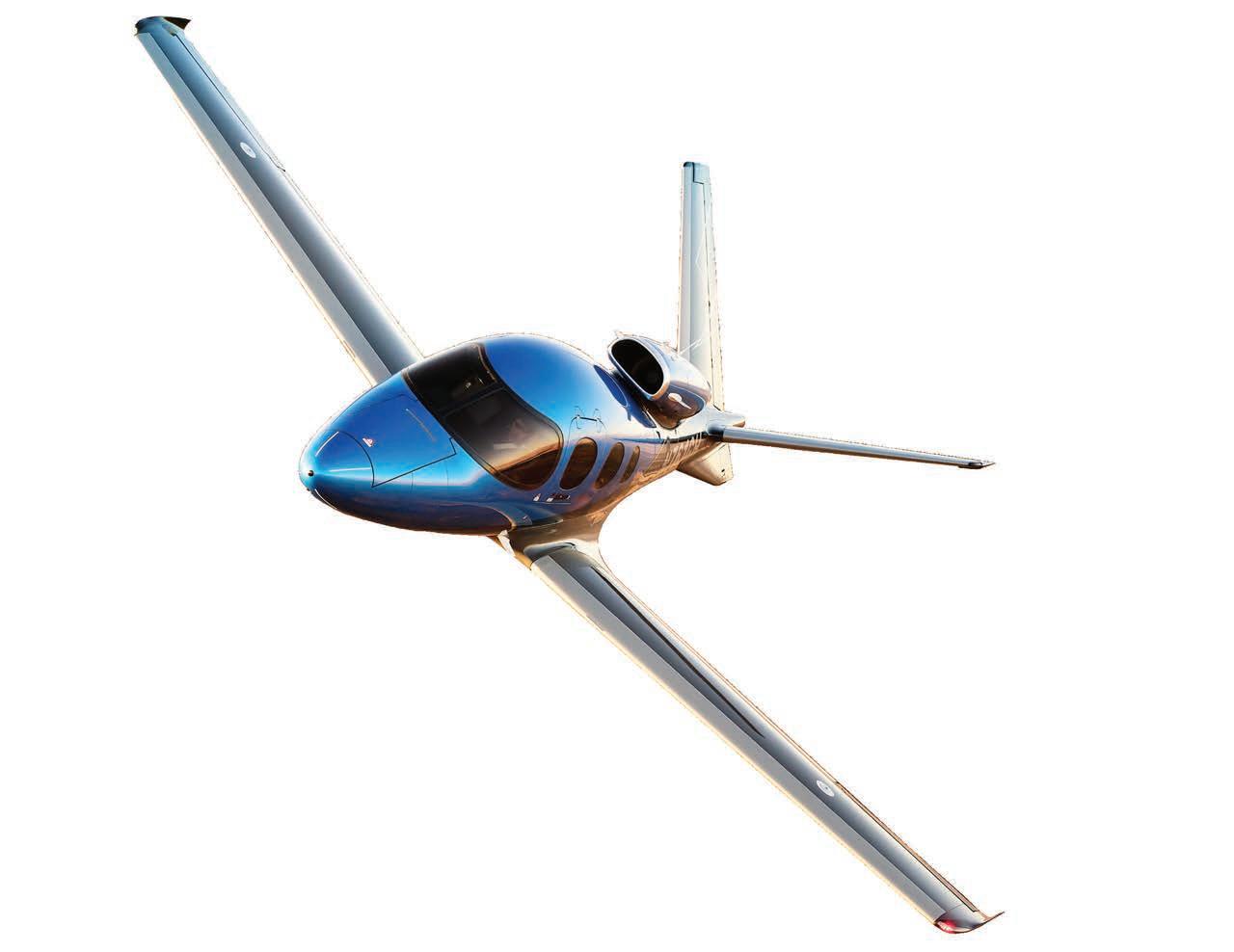
Experience the perfect supplement to your existing fleet with a world-class experience for your crew and passengers with onboard Wi-Fi and award-winning safety systems. With best-in-class fuel performance at less than 70 gallons per hour in cruise, the Vision Jet is unmatched in regional mission performance.

By Amy Wilder
Go Rentals is marking its 30th anniversary with a series of leadership appointments and promotions that reflect the luxury car rental company’s continued growth and its close partnership with the business aviation community.
“This has been an amazing year,” Kaye Gitibin, Go Rentals’ CEO and co-founder, told AIN. “We started with a vision to create a niche market within aviation, and we’ve stayed focused on that mission ever since. Our partners see the value we bring to their clients by extending the same level of hospitality they receive in the air, when they arrive on the ground.”
Founded in 1995 by brothers Kaye and Kavous Gitibin with just seven cars, Go Rentals now serves more than 300 FBOs across 32 states. The company tailors its services exclusively to private aviation and elite hospitality and has expanded steadily through longstanding partnerships.
Gitibin says Go Rentals’ concept of luxury goes beyond traditional notions of price or exclusivity. “When you provide hospitality, you have to understand your guest needs,” he explained. “It’s not one size fits all in hospitality. For some people, luxury is going and camping [by] a quiet river and talking to nobody. For some people, luxury is to be in a Rosewood Hotel, five-star hotel, and be catered to.”
Those are what make luxury, luxury. We know our guests can buy anything they want to buy. The only thing they cannot buy is time.”
Go Rentals recently advanced two longtime executives to senior leadership roles. Trissy Pickett was named senior v-p of aviation development and industry relations, and Clair Joseph became senior v-p of aviation partnerships. Both are recognized across general aviation for their leadership and advocacy of women in the industry.
Hesari as v-p of marketing, both tasked with broadening Go Rentals’ reach and enhancing its brand presence in aviation and hospitality.
Gitibin says the leadership expansion underscores the company’s evolution from a small regional operation into a national enterprise serving high-net-worth travelers, aircraft owners, and flight departments. “For nearly 30 years, we grew by loyalty and relationships without spending on marketing,” he notes. “But now, with our size and scale, we needed to invest in business development and marketing to prepare for the next phase.”
Go Rentals became the first car rental company to earn certification under the National Air Transportation Association’s Safety 1st program earlier this year—recognition that places its personnel training and operational practices alongside aviation safety standards used by FBOs and charter operators. The company also maintained its distinction as the only car rental brand recognized by Forbes Travel Guide for service excellence for six consecutive years, according to Gitibin.

He adds that genuine luxury “doesn’t [have to] mean expensive,” but rather understanding each guest’s expectations and tailoring service accordingly. “Since after Covid, time has become luxury,” Gitibin said. “It’s not the product, it’s not the merchandise—it’s about time, it’s about convenience, it’s about safety.
To further support the company’s growth, several new executives have joined the leadership team. Martin Elliott, formerly CFO of Spanx, was appointed CFO. Shawn O’Brien, previously a partner at Bain & Company and longtime advisor to Go Rentals, became COO to oversee daily operations and strategy execution. In addition, Cory Glass joined as v-p of sales and business development, and Shayma
Looking ahead, Gitibin said Go Rentals continues to explore opportunities for international expansion. The company’s minority investment partner, RedBird Capital Partners—whose portfolio includes the Boston Red Sox owner Fenway Sports Group and FBO operator Aero Centers— has opened potential pathways for growth in Canada and Europe.
“We’re studying logistics, locations, and regulations carefully,” Gitibin said, “but our focus will always remain on aviation and creating memorable, seamless experiences for our guests.”
Go Rentals is exhibiting this week at NBAABACE in Las Vegas. Notably, company brand ambassador and NBA star Jason Kidd is at its convention-floor booth on Wednesday afternoon for photo ops and to sign basketballs. In addition, Go Rentals is also giving away a oneyear lease for a Mercedes-Benz GLE. Three Go Rentals vehicles are on view at the static display at Harry Reid International Airport. z


The ongoing government shutdown in the U.S. is placing strain on the nation’s air traffic controllers and the airspace system.
By Amy Wilder
National Air Traffic Controllers Association (NATCA) president Nick Daniels issued a plea for unity and action to the aviation community to end the U.S. government shutdown at the NBAA-BACE Newsmakers Luncheon on Monday. He warned that the ongoing shutdown is placing strain on the nation’s air traffic controllers and, by extension, the National Airspace System.
“Please understand my comments today will be passionate,” Daniels began. “There’s a reason for that passion, because I’m pleading with you—not to you, but with you—as a leader in aviation.”
Daniels thanked NBAA president and CEO Ed Bolen and House Transportation and Infrastructure Committee Chairman Sam Graves (R-Missouri) for their partnership and advocacy. But his remarks quickly turned to the human cost of the shutdown: “America’s air
traffic controllers—we didn’t ask to be the focus of this shutdown. Yet they’re carrying the full weight of the shutdown.”
Controllers, Daniels noted, are continuing to manage more than 45,000 aircraft and 3 million passengers daily, despite the uncertainty and not receiving paychecks. “There is no version where an American worker can work six days a week and not know how to plan to take care of their family,” he said.
“The calls have already begun…controllers are starting to look for a second job, going to their primary job during the day, and then figuring out, ‘How many hours can I go and drive an Uber to put food on the table next week?’”
He warned that as the shutdown continues, “We’ll begin seeing an entirely new introduction of risk into this National Airspace System, starting now.” The added distraction of financial stress compounds the safety threat.
Daniels urged aviation leaders to speak out. “We talk about being together. We talk about communicating for safety,” he said. “Well, now we’re communicating for safety by talking about how people live day in and day out, with no paycheck in sight.”
Concluding his remarks, Daniels issued a blunt message to policymakers: “To those responsible for the shutdown, one message: End it now.” z
Argus International has added 14 audit categories to its Gold audit standard for charter operators, which previously focused on pilot background checks, accident and incident history, verification of pilot experience, operating certificates, and insurance. The added categories give users more information about the operator’s flight operations and maintenance programs, according to Argus.

New criteria cover 14 audit categories in flight operations and maintenance.
The flight operations Gold criteria now include evaluation of safety management systems (SMS); emergency response plans; organizational structure; training programs; fatigue management; and flight operations procedures. Maintenance features cover indepth review of maintenance management; personnel qualifications; quality assurance; training; maintenance control and planning; record-keeping; parts inventory and shelf life; and documentation systems.
More than 400 charter operators hold Argus Gold ratings, and many are working on meeting the more rigorous standard or higher audit tiers.
“These enhancements ensure that Argus Gold-rated operators are aligned with industry-leading safety practices and are well-positioned to meet FAA Part 5 SMS regulations,” said Mike McCready, president of Argus International. “Achieving the Gold rating now represents a proactive commitment to safety and a clear pathway to the prestigious Argus Platinum and Platinum Elite ratings.
“Operators who pursue the new Gold standard are sending a strong message to their clients and partners: safety and quality are non-negotiable,” he concluded. M.T.

Across every aspect of business aviation, we set the standard for efciency, comfort and connectivity. From engine to fight deck to cabin and beyond, our technologies create a superior fight experience – allowing you to focus on what matters most.
Visit RTX at NBAA, booth 2245
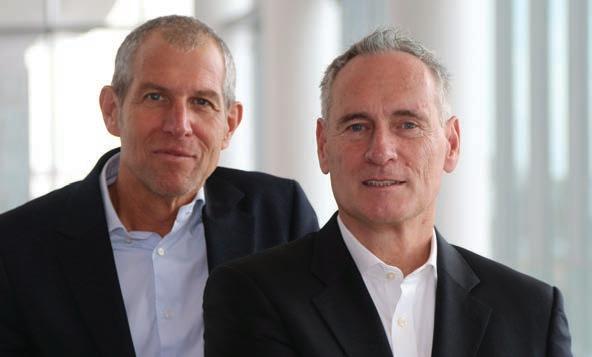
In odd years, EBACE will be held in various European locations, returning to Geneva in even years.
Pictured are Stefan Benz, EBAA CEO (left), and Juergen Wiese, chairman of EBAA’s board of directors.
By Kerry Lynch
The European Business Aviation Association (EBAA) reaffirmed that Geneva will remain the home of the European Business Aviation Conference and Exhibition in 2026 as it moves to reinforce the event’s position as the “voice of business aviation” on the continent. In even years, the organization plans to hold its annual event in the Swiss city, and for odd years it will be held at different locations throughout Europe.
EBACE 2026 will “build on a new vision for the show” following the 2025 evolution without the partnership with NBAA, the organization said. EBAA noted that it is forming an EBACE Advisory Council comprising key stakeholders to guide improvements in areas such as static display set-up, privacy and security, cost sensitivity, and operational benchmarks.
The council will also provide input on the “EBACE Goes to Europe 2027” effort, as the organization evaluates future locations to host the show. “Future locations will be selected to reflect Europe’s diversity and address the regional regulatory and operational differences that shape the business
aviation landscape, with Geneva remaining the anchor,” EBAA said.
As for the return to the Peace Capital, where the show has been held since its inception, EBAA CEO Stefan Benz said. “We’ve been pleasantly surprised by the positive and supportive reaction to EBACE remaining in Geneva with a static display. Switzerland remains the center of business aviation in Europe, and Geneva combines outstanding connections, a strong financial ecosystem, and a clear appeal to the industry’s end users.”
Benz maintained that, in the past, the true value of Geneva was not fully realized. “For EBACE 2026, our goal is to build on that foundation and ensure the city’s strengths, its accessibility, professionalism, and global outlook are used to their full potential.”
The renewal in Geneva followed the leadership change in June, when Benz came on board. At the time, EBAA was poised to announce a decision on location. But the organization opted to put that off by a month before it revealed its plan. “We wanted to give [Benz] the chance to dive into the topic and also have a complete overview of where we stand and what the ideas were,” said Juergen Wiese, chairman of the EBAA board of
governors. “We are now in preparations for this,” Wiese said.
But beyond the location, the organization wants to take a holistic view of the event. Benz added, “There was a wish for change.” He pointed to the slide over the past couple of years in visitors and the movement toward more of a classic B2B environment and networking-focused event, rather than also serving as a B2C, client-based event.
This movement, along with the shift of EBAA as the sole host of EBACE, prompted a review of “what do we want to do,” Benz said. While NBAA is no longer a part of hosting the event, Benz stressed the ongoing cooperative relationship the organizations maintain as they both advocate for the business aviation community.
In charting a path forward, EBAA gathered feedback from exhibitors and other stakeholders and found a desire to return more to an event that draws clients, whether high-networth individuals, family offices, or others involved in business aviation, he said.
Logically, he continued, that was a driver for OEM to exhibit and, as a result, for a return of the static display. However, Benz added, EBAA is considering only holding the static display when EBACE is held in Geneva every other year. This appears to be more in line with the preferences of OEMs, which are working to spread their activities among multiple shows in a given year.
EBAA also decided on Geneva not only for the setup with the static and convention center location, but also for the strong support from the airport, which is a top business aviation facility in Europe, as well as the attributes of the city as a cultural center. “We believe this is the best place, and it is also a tradition, which is not to be underestimated,” Benz said.
In addition, the organization wants to ensure moving forward that the show maintains its focus on price and security, but still creates an atmosphere of accessibility and facilitates the ability to network.
However, Wiese noted, while EBAA isn’t revealing all details just yet, some concepts from 2025 will return, such as the fresh look, starting with the entry into the hall and the zones that enabled visitors to connect. EBAA received positive feedback about those changes. z
Boeing is offering a unique program perfect for heads of state seeking to fly the Queen of the Skies

BOEING 747-8 VIP in a class of its own
An opportunity to own the most exclusive 747-8 aircraft enhanced with a new VIP cabin
17 hours of nonstop range
The largest VIP cabin ever
Gulfstream’s Repair and Overhaul Center is now open at Fort Worth Alliance Airport.

By Matt Thurber
The new Gulfstream Aerospace Texas Repair and Overhaul Center at Fort Worth Alliance Airport (KAFW) is o ffi cially open, adding more component MRO capabilities to the company’s service arm. KAFW is also the location of a three-year-old Gulfstream factoryowned service center.
Gulfstream spent $21 million to build the new facility, which encompasses 100,000 sq ft and houses more than $5 million of dedicated parts and inventory for repairs. MRO activities at the center include wheels, brakes, batteries, hydraulics, structures, and composites. Plans call to add avionics, landing gear, and other components to the menu.
“By expanding our in-house repair and overhaul capabilities, we’re expediting turnaround times and increasing parts availability to best support our customers’ needs while maximizing safety, quality, and efficiency,” said Gulfstream president Mark Burns. “We will continue to invest in component repair, maintenance support, and spare parts to enhance overall service for our customers, particularly as our fleet continues to grow.”
The number of employees who work for Gulfstream’s various product support entities is now more than 5,000. These include personnel who work as technicians, for field and airborne support (FAST), and at factory-owned and authorized service centers, authorized warranty facilities, and parts warehouses.
Earlier this year, Gulfstream opened an expanded service center in Mesa, Arizona. “I believe this [year] to be the single most significant investment in customer support in the history of our company,” said Lor Izzard, senior v-p of customer support.
“Mesa is much more than just the service center,” he added. “It’s now a spares distribution location. Also on the west side of the complex, we
have opened our own training center, similar to what we have in Savannah, because we want to be in charge—obviously—of quality and safety.”
Spanning 225,000 sq ft, the Mesa facility features an air-conditioned hangar, full-span crane, and two tail dock stations. There is enough space for a mix of 13 aircraft inside and eight on the ramp.
“We also have 36 beautiful customer offices and a customer lounge,” Izzard said. “The Mesa service center provides a deeper level of inspection and maintenance with avionics installations and structural repair capability on all Gulfstream models.”
Placing parts at strategic locations is just one way Gulfstream is able to keep customers’ airplanes flying. Since 2023, the product support division has used aircraft data to predict and prevent service interruptions, according to Izzard. “We started this quietly in 2023, but it’s a full-blown program now,” he said.
On more than 170 occasions, the system has alerted the technical operations team that a component on a specific airplane is failing, according to Izzard. “It’s a very exciting space for us.”
Collins Aerospace’s Venue smart monitor integrated with Airshow HD is entering service on a Dassault Falcon 7X next month, marking the debut of an “all-in-one” entertainment solution that delivers 4K resolution, flight information, and streaming content to business aircraft cabins. Dassault Falcon Jet’s Little Rock, Arkansas service center will install two of the units into the aircraft’s cabin bulkhead.
Consolidating Airshow HD cabin entertainment into a single unit, the system is designed to reduce hardware complexity, lower power consumption, and simplify maintenance requirements. The monitor is scalable for installation across aircraft ranging from very light jets to bizliners.
“The activation of the first Venue smart monitor with Airshow HD marks a significant shift in business aviation in-flight entertain-

The smart monitor integrated with Airshow HD will enter service on a Dassault Falcon 7X in November after installation in Arkansas.
ment, bringing pristine resolutions, streaming content, and an enhanced user interface to more jets than ever before,” said Craig Bries, v-p and general manager of commercial avionics at Collins Aerospace.
Included with the system is a mobile application that extends Airshow HD access throughout the cabin. J.R.
By Amy Wilder
MedAire is expanding its support for business aviation operators with Contingency360, a comprehensive crisis-response solution developed in partnership with GoCrisis. The program, launching this week at NBAA-BACE, combines MedAire’s global medical and security expertise with GoCrisis’ humanitarian and operational response capabilities.
“We have a very active customer advisory board…they’ve asked us what other risks we can help with,” said MedAire CEO Bill Dolny. “Contingency360 lets us leverage our infrastructure to monitor and act when something happens.”
Designed for flight departments and operators, Contingency360 supports emergency response planning, real-time aircraft tracking, family assistance, and coordinated on-scene
response worldwide. Elmarie Marais, GoCrisis founder and CEO, said the partnership ensures that business aviation clients have access to resources traditionally reserved for airlines.
“We work with operators before anything happens to make sure their plans and training are in place,” she said. “When an incident occurs, we become their boots on the ground—supporting crews, families, and communications in a way that protects both people and reputation.”
Medication—with contents organized alphabetically for faster identification.

MedAire also introduced its new Advanced Aviation Medical Kit, a redesigned in-flight kit that improves accessibility and efficiency when seconds matter. The updated kit features three clearly labeled interior bags—First Response, Bandages, and
Visitors to NBAA-BACE can again experience MedLink LIVE at the MedAire booth, observing medical experts take real-time in-flight calls that demonstrate how physicians guide crews through emergencies. MedLink LIVE shows what the organization’s doctors do every day—helping crews manage critical medical events and return flights to normal operations safely.
As part of its 40th anniversary, MedAire founder Joan Sullivan Garrett will lead a live discussion, “Life and Death at 40,000 Feet: The Stories Behind Aviation’s Greatest Medical Saves,” today, October 15, at 1:15 p.m. in the Flight Deck zone. z

EAP is celebrating our ninth year and we’ve added more engines and APUs from GE, Honeywell, Pratt & Whitney Canada and Rolls-Royce to our hourly engine maintenance program.
Visit us at NBAA-BACE in booth 1145 to see if we cover your engines. Call 214.350.0877 or go to eap.aero for the complete list of engines we cover
By Kerry Lynch
Scholarship resource program AviationStart is marking its first major collaboration at NBAABACE with the unveiling of an AI-powered Aviation Career Resource. Jamail Larkins, who has served as the FAA ambassador for aviation and space education since 2004, created AviationStart this year, in partnership with industry, academia, and the agency, to offer a free national resource to help aspiring aviation professionals find scholarships, mentorship programs, and a career roadmap.
“With the support of some industry stakeholders, our goal is to make a central resource for the entire industry, compiling more than $20 million in available scholarships and grants,” Larkins said, noting that the resource can serve as a venue to access national organizations, state/regional associations, and airshows that offer scholarships and grants.
At NBAA-BACE, the program is showcasing its first generation of the Aviation Career Resource, where students or aspiring professionals can enter basic information such as career goals, location, age, and gender, and instantly get matched to scholarships and

professional organizations that can help them.
AviationStart builds off the FAA DreamLaunch Tour Partnership, which has served as a student outreach program. This program, Larkins said, is a simple idea that evolved into one of the largest aviation education and workforce development partnerships that has reached more than 1,000 schools, museums, and colleges nationwide.
“The tour isn’t just a motivational speech, but an actual aviation workforce development platform,” Larkins said, pointing to research from Embry-Riddle Aeronautical University that showed a 60% increase in applications to aviation
programs after the DreamLaunch Tour visits.
Meanwhile, the Career Zone is a new feature at NBAA-BACE, bringing together various workforce programs and adding new features.
“Whether you’re a student, young professional, mid-career expert, or transitioning military member, the NBAA-BACE Career Zone provides valuable resources and opportunities to support your next career move,” said NBAA senior v-p of events and professional engagement Jo Damato.
Open Wednesday from noon to 5 p.m. and Thursday from 9 a.m. to 2 p.m. in the West Hall of the Las Vegas Convention Center, the Career Zone will also offer a career fair; career coaching with Jenny Showalter, founder of Showalter Business Aviation Career Coaching; opportunities to meet industry luminaries such as former U.S. Air Force Thunderbird Michelle “Mace” Curran; a “headshot lounge” to have a professional photo taken; and networking opportunities.
“This is always a great opportunity to build on existing industry relationships, as well as engage with emerging talent to gain insight into the evolving aviation workforce and share some of the exciting opportunities we have for crewmembers, maintenance, flight operations, and other candidates,” said Penny Stocksdale, senior talent acquisition partner, Jet Aviation. “Our staffing team looks forward to interacting with professionals and helping them find their next career prospect in business aviation.” z
Desert Jet Maintenance (DJM) has introduced the DJM Service Plus Rewards Program to recognize clients for their continued patronage. DJM is an FAA Part 145 MRO and FBO at Jacqueline Cochran Regional Airport (KTRM) near Palm Springs, California.
The Service Plus Rewards program awards one point for every $10 spent on labor, redeemable for rewards such as gift cards, luxury items, experiences, resort stays, round-trip airfare, and a 2025 Harley Davidson Breakout motorcycle.
“Our clients have always been at the heart of everything we do,” said Desert Jet CEO Jared Fox. “This program is our way of giving back, recognizing that maintaining their aircraft not only ensures safety and performance but now also brings exciting personal rewards.”
General manager Valente Camarillo emphasized that the program reinforces DJM’s commitment to maintenance excellence while providing clients with additional benefits for choosing their Palm Springs-based services. J.R.
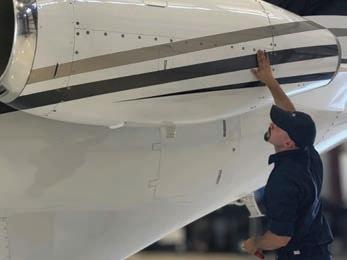
DJM Service Plus Rewards program awards points to customers for spending on labor.
By Curt Epstein
Honeywell is expanding its flight management system (FMS) guided visual approach functionality into Europe. The company’s FMS guided visual (FGV) approaches have been available in North America since 2023, with the technology improving the chances of a stable visual approach by offering a precise, repeatable flight path that can be fully coupled to the autopilot or hand flown.
Titled “RNAV H” to differentiate from other RNAV instrument approaches, these procedures are an addition to the current FMS navigation database subscriptions, for use by operators conducting a visual approach to the runway. No regulatory approvals are required for FMS-guided visuals, Honeywell noted, and they can be loaded directly from the FMS navigation database.

The system provides lateral and vertical guidance to the runway during visual approaches at more than 30 airports in North America and Singapore, and they are now available at six European airport/runway combinations, according to the company. These include Cannes-Mandelieu (LFMD) and Nice Côte d’Azur (LFMN) airports.
The FGV approaches are applicable to a variety of Honeywell avionics-equipped
aircraft, including the Bombardier Global Express; Cessna Citation Sovereign and X; Dassault Falcon 6X, 7X, 8X, 2000EX EASy, 900EX EASy, and 900C/EX; Gulfstream G450, G550, G650, G500, G600 and V; Hawker 4000; and Pilatus PC-12 and PC-24.
“Stabilized approaches offer pilots a range of benefits, from preventing overbanking and potential stall conditions to helping maintain situational awareness in conditions that make it difficult to identify the runway,” said Jim Johnson, senior manager of flight technical services at Honeywell Aerospace Technologies. “They also offer the added ability to prevent steep approaches, which can otherwise lead to additional brake wear, noise from maximum thrust reversers, and runway overrun. By integrating our FMS technology, pilots can now make a safer, more stabilized approach to challenging airports in a more efficient manner.” z

By Jessica Reed
Innovative Advantage introduced an onboard Dolby Atmos decoder card and an Airmont gateway card for DirecTV content decoding yesterday at NBAA-BACE.
The enhancements to the audio/video distribution system (AVDS) platform mark an upgrade from the system’s existing Dolby Atmos passthrough functionality. While the current architecture allows commercial-offthe-shelf players to integrate with external Dolby decoders through the AVDS backbone, the new decoder card performs Dolby Atmos processing directly within the aircraft’s
distribution infrastructure, delivering immersive audio without requiring separate decoding hardware.
With the Airmont gateway card, optimized signal management and decoding specifically for DirecTV broadcasts are provided. According to the company, the card ensures high-definition playback quality while managing bandwidth utilization and integrating with the existing AVDS backbone architecture.
“These new cards represent the next evolution of our AVDS platform, expanding our support for audio/video content,” said Nestor Fenoy, director of systems engineering at Innovative Advantage. “For 20 years, we’ve

By Curt Epstein
JetNet announced the launch of its next-generation AI-driven market intelligence platform this week at NBAA-BACE 2025. According to the company, the new functionality will integrate explainable generative AI directly into its aviation data ecosystem.
“JetNet AI represents the future of aviation intelligence,” explained Greg Kimball, the Utica, New York-based data analyst’s chief product officer. “We’re empowering professionals to ask natural language questions of
their data and get instant, accurate insights from across fleet, flight, and market intelligence, securely, within their daily workflows.”
Attendees visiting the JetNet booth at the Las Vegas Convention Center during the course of the show will receive exclusive early access to join the AI beta testing program.
“NBAA-BACE is the perfect stage to unveil JetNet AI, our most transformative innovation yet,” said company CEO Derek Swaim. “This launch marks a major milestone in our mission to deliver instant, actionable intelligence to aviation professionals.” z
been proud to serve as the cabin backbone of business aviation, providing a modular, reliable, and future-proof AVDS solution.”
The announcement coincides with Innovative Advantage’s 20th anniversary. Part of Heads Up Technologies Group, the company has installed its AVDS systems on more than 2,000 aircraft in both OEM and aftermarket applications.
This week at NBAA-BACE 2025, Heads Up Technologies Group is demonstrating the Dolby Atmos capability through an integrated setup featuring Innovative Advantage’s AVDS backbone, Alto Aviation cabin audio systems, and Heads Up Technologies’ lighting and control systems. z
Hartzell Propeller and Blackhawk Group have formed a strategic partnership that will expand the o erings and service network of the latter company. Under the collaboration, Blackhawk Group’s customers will have access to fixed-rate pricing, a more e cient overhaul process, and Hartzell’s service centers across the U.S. and in Europe. The agreement guarantees overhaul pricing, including parts, pickup, and delivery, as well as lead times and budgeting and forecasting, access to Hartzell network exchanges and rentals, and two-year/2,000-hour warranty coverage.
“By combining Hartzell’s proven propeller technologies with the Blackhawk Group’s network of performance centers, we are creating a seamless path for customers to access upgrades, maintenance, and support that maximize performance, reliability, and operational e ciency,” said Hartzell Propeller president J.J. Frigge. A.W.
By Charles Alcock
Aviation document management specialist Web Manuals is offering special rates to NBAA-BACE show attendees for its Amelia Co-Author platform. The company launched the artificial-intelligence-based editing tool in May and has now been providing digital document support to the business aviation sector for five years.
New customers who sign up in Las Vegas this week or before December 31 will receive 10 million tokens with their first Amelia Co-Author license, and another 5 million tokens for each additional license purchased. The tokens serve as credits for AI usage and are intended to give clients a low-risk way to try the technology. Web Manuals is also offering a 50% discount on licenses as part of the show offer.
“On average, a single request consumes around 7,000 tokens,” explained Richard Sandström, the Sweden-based company’s chief technology officer. “10 million tokens allow for thousands of AI-assisted edits, rewrites, or table generations. It’s an easy way to explore without over-committing on day one.”
Amelia Co-Author is part of Web Manuals’ Amelia AI suite developed to help technical editors and compliance professionals be more efficient with writing, rephrasing, and structuring regulatory content. Users can ask for prompts directly within the Web Manuals platform, generating refined outputs such as simplified language, formatted tables, and reorganized sections in aviatio n documents.
Since early 2020, Web Manuals has increased its customer base by 306%. Initially, more demanding compliance requirements drove demand for the technology and, especially during and postCovid, aviation companies have needed an increasingly digital approach to document management.
“Business aviation is certainly leading this charge, with our customers in this segment outnumbering airlines by almost four to one,” said Justin Raymond, Web Manuals’ director of operations for the Americas. “It was compliance linking that initially drove this uptick. It meant that changes in regulations were quickly identified and traced across all of an organization’s documentation, ensuring traceability, accountability, and efficiency in managing regulatory compliance.”

According to the company—which also has offices in New York, San Diego, Sydney, and Singapore—the introduction of AI-based tools has streamlined these processes even more. It
said this has given operators faster access to insights and compliance requirements.
“When we adopted Web Manuals in 2020, our goal was to simplify the admin side of manual management, and it has proven to be a long-term solution we’re very pleased with,” said Greg Mangione, director of operations at Northern Jet Management, a Web Manuals client. “Compliance linking makes it easier to demonstrate regulatory alignment during audits, and our manuals are now cleaner, standardized, and much easier for our team to manage and edit.” z
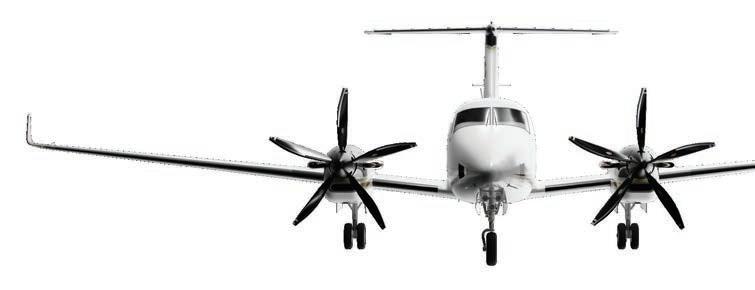
No matter your propeller preference, the choice will soon be yours.
Flight testing for the Hartzell 5-Blade Composite Propeller is complete, and STC approval is coming soon.
With the proprietary Blackhawk XP67A Engine+ Upgrade, you can transform your King Air 350 into the most powerful King Air on Earth … and leave ordinary behind.

By Charles Alcock
Cirrus Aircraft is expanding flight training options for Vision Jet pilots with the addition of a simulator at its facility in Scottsdale, Arizona. The simulator, built by CAE, replicates the flight deck of the very light jet to provide recurrent training in procedures, maneuvers, and emergency situations.
Located close to Cirrus’ existing facility at Scottsdale Airport (KSDL), the simulator has the capacity to be used by 45 pilots each month. The manufacturer will start recurrent training at the site in March 2026.
Cirrus Scottsdale provides flight training for both the Vision Jet and SR Series piston aircraft through the Cirrus One program. Now, the company said, it is recruiting additional instructors, simulator technicians, and administrative staff
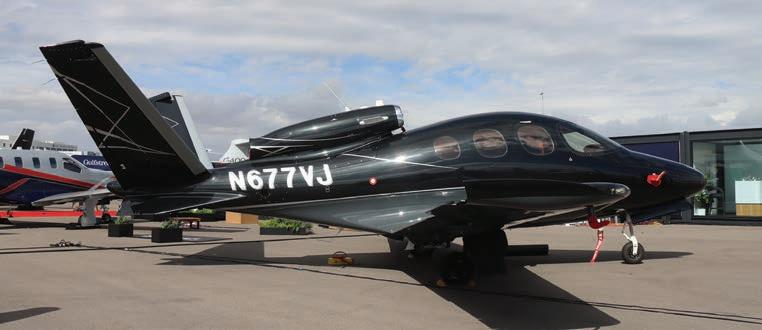
“Cirrus is making Vision Jet flight training more accessible to customers on the West Coast,” said company CEO Zean Nielsen. “We are expanding flight training in Scottsdale, enhancing our capacity and convenience for our customers. The Cirrus Scottsdale investment is integral for our new community seeking Vision Jet recurrent training.”
Boeing Business Jets has introduced a new way for customers to own VIP versions of the 747 jumbo jet. On Tuesday at NBAA-BACE 2025, the airframer announced a “turnkey service” option through which it will acquire preowned 747-8s and extensively customize their cabin interiors before delivery, with full support provided when they enter service as BBJ 747-8s.
The 747-8 was the last version of the widebody airliner family and entered commercial service in 2012. For private operations, the BBJ version of the airframe offers almost 5,000 sq ft of cabin space that Boeing is now offering to reconfigure to meet customer specifications under a single contract, avoiding the need to use a separate completions contractor.

Boeing can reconfigure nearly 5,000 sq ft of cabin space in the BBJ version of the 747-8 for customers.
As it approaches the 10th anniversary of the Vision Jet program, the Duluth, Minnesota-based manufacturer said it has delivered almost 700 examples of the seven-passenger, single-engine aircraft. Cirrus markets the model for personal or business use, as well as for Part 135 charter operations. z
According to Boeing, the BBJ 747-8 can fly up to 75 passengers with a range of 8,500 nm. This would allow nonstop trips between city pairs such as New York to Bangkok and Dubai to Los Angeles.
Today, there are nearly fifty 747-8s in service, including several used for business and government transportation. The 747-8 Intercontinental model incorporates technology from Boeing’s 787 Dreamliner aircraft, and so it has a lower noise footprint, as well as reduced fuel consumption and operating costs compared to earlier 747 family members.
Boeing Business Jets is at the NBAA-BACE show promoting what it calls the “Queen of the Skies” 747 legacy. Its turnkey service option ensures that operators have full access to Boeing’s global network of parts and approved engineering and maintenance support.
“The 747-8 continues to serve as a premier VIP and head-of-state aircraft, and discerning customers are interested in continuing this tradition of excellence in private air travel,” said Joe Benson, president of Boeing Business Jets. “We’re thrilled to continue this legacy with the Boeing-backed 747-8 VIP—delivering a personalized and exceptional flying experience.” C. A.
By Curt Epstein
Following nearly 20 months of construction, Sheltair will debut its newest location with the opening of its FBO at Sarasota–Bradenton International Airport (KSRQ) on November 1. For the Florida-based aircraft service provider, this represents its 17th FBO location overall and the 13th in its home state.
Occupying 25 acres on the field, including 12 acres of ramp, the $40 million development will feature a 10,705-sq-ft terminal with 11,680-sq-ft airside arrivals canopy; large, naturally lit lobby; two conference rooms seating eight and 14, respectively; VIP lounge; and pilot lounge and concierge.
In addition, the complex will include 46,530 sq ft of hangar space capable of accommodating the latest ultra-long-range business jets, nearly 10,000 sq ft of office space, and a fuel farm holding 40,000 gallons of jet-A and 20,000 gallons of avgas. Initial hours of operation will be from 6 a.m. until 10 p.m., changing to 24/7 next year.
Sheltair noted that a CBP inspection facility is set to open on the field in second-quarter 2026, and it plans to add more large hangars and a 60,000-sq-ft MRO facility to its leasehold.
Meanwhile, the FBO chain and fuel provider Avfuel named the six recipients of this year’s Sheltair x Avfuel: Future Takes Flight Scholarship, selected from more than 1,100 entries, this week at NBAABACE 2025. Now in its fourth year, the program awarded six $5,000 scholarships across three categories.
This year’s class includes Trent Hartle of Traverse City, Michigan, and Kamiron Anderson of Salt Lake City for aviation technicians; Jalen Dennis of St. Louis, Missouri, and Mary Springer of Pittsburgh, Pennsylvania, for continuing education; and Theodore Johnson of Ypsilanti, Michigan, and Aidan Hillegass of Oxford, Pennsylvania, for the Learning to Fly category.
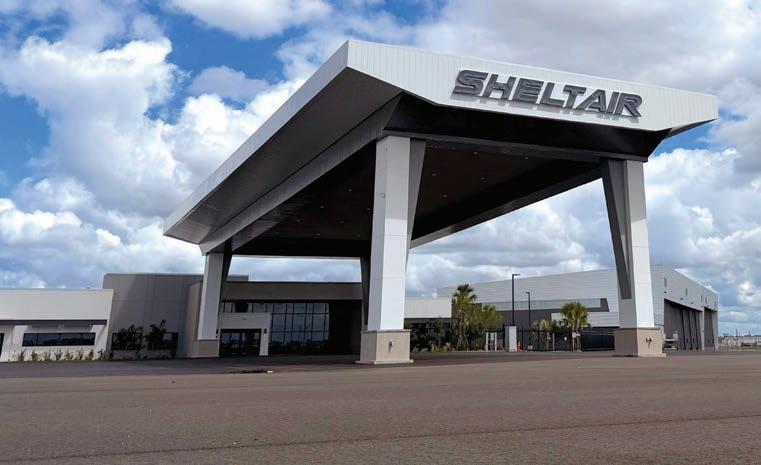
“Each year, this scholarship gives us the privilege to spotlight remarkable people who are building their futures in aviation,” said Sheltair president and CEO
Sheltair’s
Lisa Holland. “We’re honored to invest in their training and can’t wait to see how they elevate business aviation in the years ahead.”



By Kerry Lynch
Companies participating in NBAA-BACE should plan early, focus on quality meetings versus quantity, and remain engaged and prepared for their audience, according to marketing specialist Paula Williams, who founded Aviation Business Consultants International (ABCI).
Williams, who is attending NBAA-BACE to support her clients and engage with potential new ones, provided strategies on how to manage a busy show where it can be hard for small companies to get noticed. This starts with preparation, she said.
“We have a checklist that actually starts 90 days before the show for our marketing clients, whether they’re actually working the show or exhibiting,” she said. This includes
doing research on who they are going to meet, deciding on how they can add value, and “book themselves solid while they’re in town” so they can do as much in person as possible.
“It’s so nice to be in the same town, and it puts things on a different level if you can sit across the table with somebody and work with them,” Williams said.
Emphasizing the need to have quality meetings, she added, “If you are a small or medium-sized company, you can’t get a bigger booth. That’s why I recommend doing the work ahead of time so that you’re bringing value to the table. Then it’s always quality over quantity. So, the people that you most want to meet with, you’re doing that. If you can do 10 of those appointments over the three days that you’re there, I think it’s more valuable than having thousands of
people come to your booth and take a pen and run away.”
Williams also detailed common mistakes she’s seen made at conventions, key among them a lack of preparation of their teams. “Some companies will have a booth, and they haven’t really prepared their staff. They haven’t done an FAQ. They haven’t done role-playing,” she said. “It’s fairly obvious because the people who are in the booth are a little uncomfortable. They’re spending a lot of time on their phones or their tablets, and they’re not really that approachable.”
And when they are approached, she continued, the sta ff may not be prepared. “I think role-playing is vastly underrated. It’s so hard to do, but it’s so valuable to help people feel comfortable.”
For a strong marketing framework, she said companies must focus on the list, offer, and presentation: Who is the ideal customer, what can the company do better than the alternatives, and how and where are you communicating the message. “Then we can figure out all of the decisions come from those three elements.”
She also noted that social media can be a good tool for support, but it is more effective when integrated with other marketing tools, such as shows or advertising. “I think that Covid really exposed some of the value of social media as part of a marketing campaign. I think social media is a great extension of lots of other presentation formats in marketing, but I don’t know that it’s that effective by itself if it’s all you’re doing because our demographic is old-school.”
Williams has seen a growing need for marketing support for smaller aviation firms, especially post-Covid. “I think it used to be pretty traditional to have a marketing person on staff or a marketing team or a sales and marketing team. A lot of folks have downsized since [Covid] happened,” she said, adding that ABCI strives to serve as a “fractional marketing department” to support these companies or others that need additional help. z

AINalerts delivers the news and intelligence that directors of aviation, chief pilots, flight department leaders, OEMs, MROs, and industry executives need to stay ahead. Trusted reporting, exclusive analysis—delivered straight to your inbox Monday through Friday.





By Kerry Lynch
Two years after private equity firm AE Industrial Partners (AEI) acquired a majority interest in Yingling Aviation, the iconic Wichita maintenance, repair, and overhaul (MRO) business is undergoing a transformation that is rapidly expanding its size and capabilities with additional hangars, multiple acquisitions, and new services such as winglet installation and paint capability for the largest business jets.
However, company executives stress that the nearly 80-year-old company has not forgotten its roots as a long-time piston, turboprop, and light-jet services company, and in fact is enhancing that business as well. Yingling was founded in 1946 as the first Cessna Aircraft dealer, a relationship that has endured for eight decades.
It spent most of its first 77 years as a familyowned business, initially with the Yingling family and then later, in 2000, the Nichols family. The MRO was sold in 2023 to AEI, which has,
over the years, invested in well-known, successful aviation services businesses such as West Star Aviation, Global Jet Capital, StandardAero, Solairus, and Landmark Aviation. After the AEI acquisition in 2023, CEO Lynn Nichols has remained on the board and his son, Andrew, has continued as chief strategy officer.
AEI, however, brought over two thenretired executives from West Star Aviation: Robert Rasberry and Rodger Renaud, who took the roles of CEO and COO, respectively, in October 2023. They are working with the Yingling team and new ownership to expedite an ambitious growth trajectory that would see it acquire three local businesses within a year—in September 2024, Bevan Aviation, a 70-year Wichita fixture that brought avionics specialization capabilities; in March 2024, neighboring Mid-Continent Aviation Services (MCAS), a full-service MRO that provided a range of capabilities; and in January 2025, Global Engineering & Technology, which expanded on Yingling’s aircraft cabinetry and interior refurbishments capacity.
Not only have those acquisitions brought new specialties, but they have also provided much-needed space for Yingling’s quest to push up into the largest of business jets. MCAS added 80,000 sq ft of hangar capacity. And now Yingling spans 14 hangars, 550,000 sq ft of total space, and 450 employees, a number that is rising daily.
The company is not done, looking for additional space as it spreads out at Wichita Dwight D. Eisenhower National Airport (KICT), just across Runway 19L/1R from Textron Aviation’s sprawling campus. Notably, it is preparing to break ground on 60,000 sq ft of hangar space for a paint facility that will be large enough to accommodate the Bombardier Global 7500. Construction is set to begin next year, with completion in 2027.
But Renaud told AIN that customers have already begun lining up for paint, reflecting not only their long-time relationships with a mix of customers but also a real shortage of such paint capacity. Yingling has begun training for work on such a scale, so it will be


JANUARY 15 - 17, 2026
“The AIN CALS event has been a refreshing experience for leaders within the corporate aviation community and the vendors that support their businesses. 100% engagement for 2.5 days. Truly a working event that leaves us all a bit tired but very enthused!”
– CALS FLIGHT DEPARTMENT ATTENDEE
“The AIN CALS event provides excellent opportunities for high level interaction between vendors and clients. The one-on-one time and small group sessions are very valuable settings.”
– CALS SPONSOR
ready to go once it opens. One beneficiary may be Bombardier, which already contracts with Yingling for certain paint work.
Those relationships that Rasberry and Renaud have cultivated over their decades in the industry have helped Yingling build up an entirely new clientele: the large business jet owner.
That business really began to spool up after they arrived at Yingling. “The day we came, we knew that’s where we were headed,” Rasberry told AIN. “We laid a lot of groundwork. We had to make sure we had what we needed: resources—people, hangarage, obviously tooling, and all that—so that we didn’t fail. So we didn’t really announce that we were here while we put some team together.”
But customers still called, he said, and they responded, “We’re not going to take something until we know we [are ready]. Once we were ready, we announced, and holy cow.”
The business followed. Bombardier Globals were the first two, but a recent visit showed Falcons, Gulfstreams, Challengers, and Hawkers onsite, along with the stable of Citations, Caravans, King Airs, and other longtime regulars.
Rasberry and Renaud said the evolution was not new to them, noting that West Star was a piston/turboprop shop before they came on board. Now West Star is one of the largest business aviation providers in the U.S., with multiple locations and a spectrum of capabilities across the business and general aviation fleet.
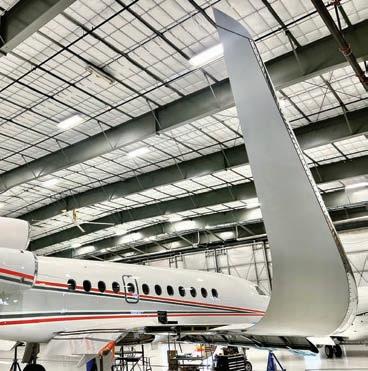
“We had really good people. We empowered them. We guided them. We talked with them. We allowed them to make decisions,” Rasberry said. “The customers wrapped their arms around them, became their friends, and that’s how we grew it—pretty simple.”
At Yingling, the leadership has brought in technicians with expertise, but has also been able to build on their own in-house talent and the Wichita community. Being in Wichita, many of the workers already had experience and knowledge of larger aircraft.
When they joined Yingling, the facility spanned eight hangars (mostly smaller). Some were just used for storage for Yingling FBO. The MCAS acquisition provided the company with space for its large aircraft work.
The shift also reflected the trust that they cultivated with the customer base, Rasberry said. It has brought new business, such as its appointment to join the Aviation Partners network as a winglet installer. The first was ongoing on a Falcon 900, with others waiting in line. That work included the dry bay modification, required by an airworthiness directive.
While just getting started in this discipline, Renaud said this work goes back to the people Yingling has hired. “They’ve done more than anybody in the industry,” he said. And that was reflected in the smooth process on the very first installation; an Aviation Partners rep said it was among the best and fastest he’d seen, Renaud added.
Another newer capability involves Starlink satcom system installation. Yingling was on its sixth such project by last month.
Asked about what’s ahead for the future, Rasberry simply said, “Growing.” This is encompassing, he noted. “We’re going to grow the legacy programs that were already here. We’re not giving those up, but since we bought this, we’re adding the larger airplanes, all of the big names. So we’re going to grow all of those.”
As it looks at more capacity, Renaud said Yingling believes it has found a solution for more hangar space, but “we’ll need more than one. We’ll chip that way on them as we can.”
As for other acquisitions, Renaud added that the company is looking cautiously, and likely outside of Wichita. “We don’t want a project. If it’s a successful business that has good management, we would consider it, but we don’t want a project.”
Rasberry agreed: “It has to be good. It has to integrate into what we’re doing.”
As for the changes afoot internally, it initially brought caution. But long-time employees saw opportunities open up and the ability to leverage connections to get parts that, before, may have taken much longer to obtain. “It’s 100% communication,” Rasberry said. “We’re very customerand employee-focused. The whole group is.”
As for the legacy customers, he acknowledged that there may have been some early concern, “but they figured out there’s no change. That is a great business we really have.”
In the meantime, employee recruitment and retention maintains a daily business at Yingling. The MRO last month launched a major campaign, reaching outside of Wichita to lure new workers to its rapidly growing business. z
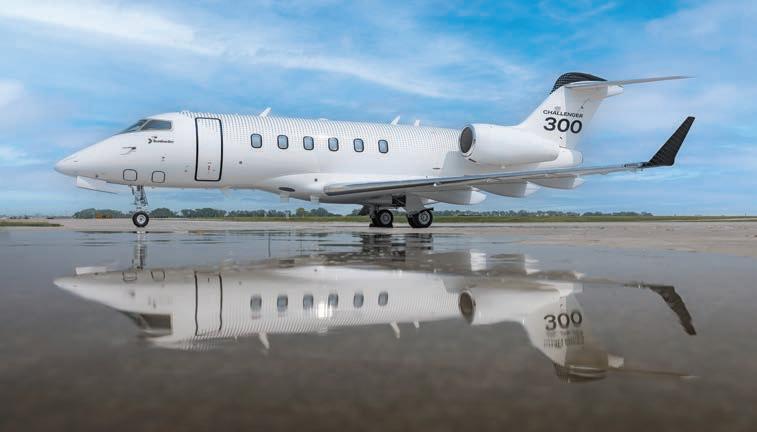
Connect with leading manufacturers, discover cutting-edge innovations, and witness the future of private aviation unfold in a booming region.

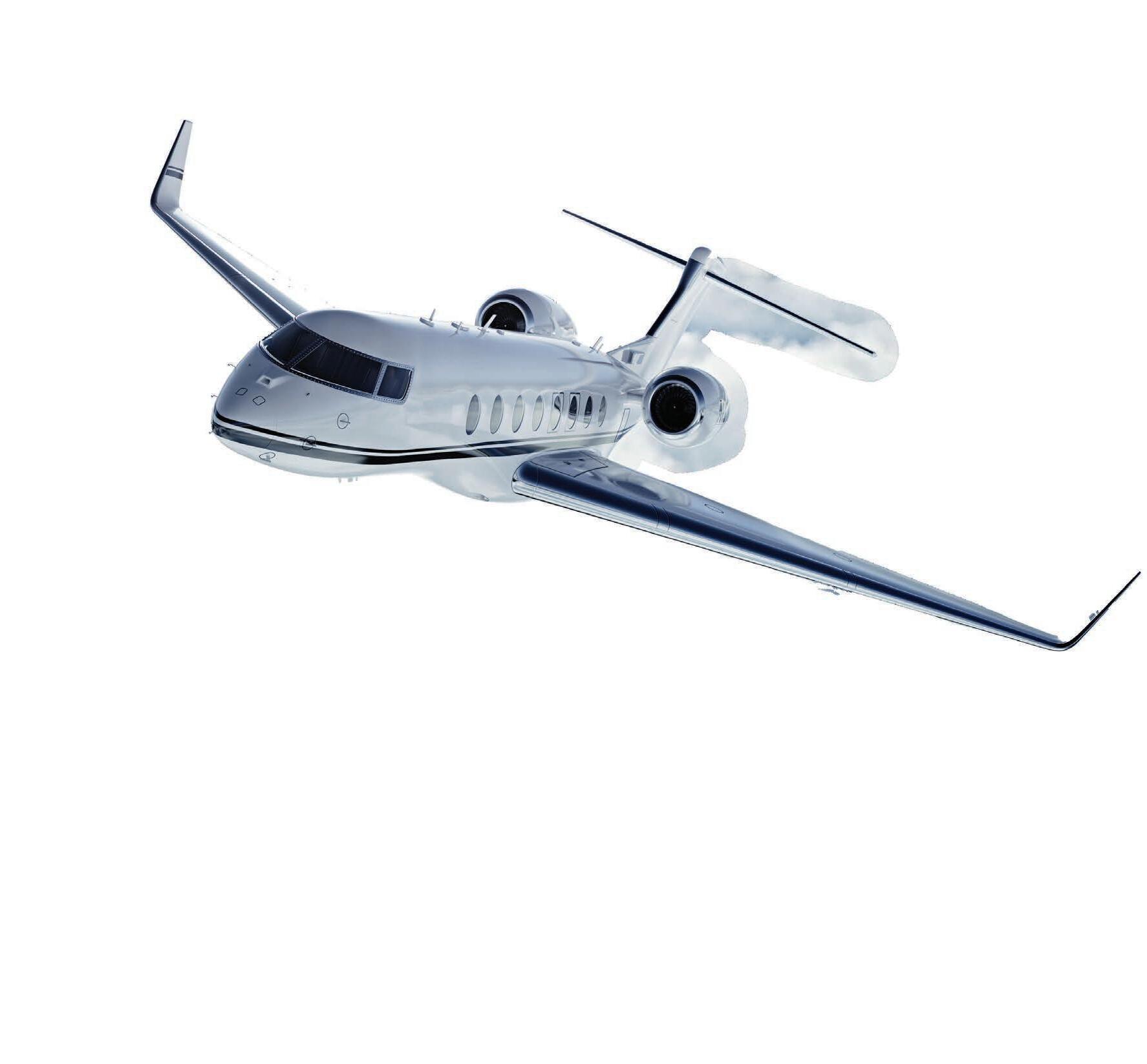

By Matt Thurber
In-flight connectivity is a rapidly evolving field where airborne internet is a must-have, not a nice-to-have. Once, passengers were hoping for the ability to text, and now they want offices in the sky. Reliability and speed have become commonplace, rather than a target. AIN brought together experts to discuss how the industry is meeting the demands of these changes and what to expect in the future.
Participating in the roundtable were Claudio D’Amico, v-p of strategic market engagement, business aviation for Viasat; Jay Heublein, president of Flexjet Technical Services; Jason Wissink, president of services and connectivity for Honeywell; and, Michael Schrage, research fellow, MIT Sloan School of Management. Viasat sponsored this roundtable
CLAUDIO D’AMICO There’s definitely a change in our industry. We went from being able to send a text on an airplane, and that was good enough 20 years ago, to using that aircraft as an extension of our office or living room. That’s the expectation when you’re flying on these business jets, but at the same time, the technology of the aircraft has improved significantly. We have airplanes flying longer distances, and I think that also has a big impact on connectivity for our industry.
[New] jets are equipped with connectivity as a must-have solution
There’s consolidation happening [with providers]. It happens in every industry that is maturing. You have innovators, then some consolidation, and we’re seeing some of that.
The demographics of our passengers are changing. At one point, speeds were very important. But now, with this maturing in the industry, we’re seeing experiences being more important. That’s how the whole customer base is evolving.
Obviously, we’re seeing LEO [low-earthorbit] entrants. From Viasat’s perspective, competition is good. It forces us to continue to innovate and bring better solutions to our customer base. We think that a multi-orbit solution backed by high-capacity and flexible satellites is where you can continue to innovate and drive improvements in terms of experience.
JASON WISSINK We’re seeing a combination of multiple things that are expanding the choices that operators have. The established providers like Viasat are adding significant amounts of capacity. We have to stay very close with companies like Viasat to understand those roadmaps, timing, modems, waveforms, all that stuff, so that when the capacity becomes available, people can get access to it.
On top of that, there are a lot of new entrants and disruptors. Starlink is one of them, and they’re driving a change into the market, in terms of what experience should be expected. As a manufacturer, we have a
combination of people that we’re partnered with, and then some folks are more vertically integrated that we still need to find a way to work with, because you end up with aircraft that have multiple systems installed. What passengers want is a system that works great and provides a great experience.
MICHAEL SCHRAGE Let’s not confuse greater capacity with capability and how that capability is experienced. The user doesn’t want to deal with complexity. They just want the thing to work. What I think is going to become very important in the business space and in the commercial space is classic UX [user experience] design— what are the personae of the users, and what are the edge cases that will test the capability of the system? If you’ve got the children of [the owners] on a jet, and they are influencers on Twitch, how well can they do stuff on Twitch as opposed to just stream a Netflix movie? What kind of latencies are acceptable?
These are the big issues. I think metadata matters. I think the intent of the user matters. I think there’s going to be more intelligence in the system, and capacity is not just going to be about speed or greater speeds; it’s going to be about facilitating intelligent continuity for the user.
JAY HEUBLEIN [Last] Sunday, we had 380 live legs. The only negative KPIs that I saw, somebody had bad catering on one flight, and on three flights that had legacy connectivity equipment, they complained that the connectivity didn’t work. Think about how complicated it is to run [those] flights. We can run a perfect flight,
Aircraft operators and other FBO users can rate airport service providers they frequent worldwide in five categories— line service, passenger amenities, pilot amenities, facilities, and CSRs—as well as give a shout out to facility sta ers who went above and beyond in providing great service.
The results will be announced at AIN’s 2nd Annual FBO Awards Dinner & Gala on March 26, 2026, and will appear in the April 2026 issue of of Aviation International News.
FBO Survey respondents will be entered to win a $250 gift card.
For more information on AIN’s FBO Awards Dinner & Gala visit AINFBOAwards.com


To access the survey and record your votes, visit: FBOSurvey.com
and now we’re down to people are focused on whether or not their in-flight connectivity experience mirrored what they expect in their office or in their homes. The expectation is that anything I can do in my home, in my office, I should be able to do in my aircraft.
The early generation stuff was great. We were all happy when we could do basic text and then, almost immediately, “I can’t stream. I can’t host video conferencing.” If you have a less-than-perfect connectivity experience, our customers think of the flight as a failure.
We realized two to three years ago that [Starlink] was going to be able to build a phased-array antenna [or ESA]. We thought that was a big step forward, because we got away from moving parts. So we decided to go all-in on Starlink. We’re an integrator for Starlink. I think [we’ve developed] about 20 STCs [supplemental type certificates], and in a year, we delivered almost 800 kits.
In the last couple of years, we’ve crossed the reliability threshold. In the 110, 120 airplanes that I have flying with Starlink, I’m aware of two mechanical issues, which, relatively speaking, is incredibly low.
CLAUDIO D’AMICO Customers have mentioned they liked the consistency and the reliability as our network grew. As we further integrate Viasat and Inmarsat, we can bring a lot more to our customers. And as we evolve equipment, in collaboration with our partners, we can also bring even more capacity.
JAY HEUBLEIN My issue is I can’t move fast enough to [upgrade]. To be clear, we’re not talking about Honeywell systems. We’re talking about older [air-to-ground] ATG-type technology, where the experience is nowhere near the same as what is available now. It’s a race for us to get them on. We started with all of our large-cabin aircraft. We got through those fairly quickly. Next week, we’ll start our last STC, which is for our light jets. It’s coming.
JASON WISSINK The existing JetWave customers have certainly begun to experience the increased capacity over North America. We’re seeing peak speeds increase quite substantially and usage going up. The reception on our newer system that we’re just finishing
up—JetWave X, we bring that into service at the end of this year—people appreciate the flexibility we built into the system. [JetWave X] over-the-air testing has begun, and we’ve got it on one of our test aircraft. We’ll be flying that here very shortly. Things are starting to move here pretty quickly. And now we’re getting into much deeper discussions with the service centers on STCs and production fit.
JAY HEUBLEIN Our large-cabin data subscription rates are probably half what they were five years ago. That’s because there are multiple solutions and not just because we have a LEO solution. But there has been a reduction in data costs.
CLAUDIO D’AMICO I think there has been. It’s about which service plan you’re selecting and how you want to operate the aircraft. One of the things that we’re focused on is how do we measure that experience, so we can quantify that experience going forward. We see speed tests on our network of over 150 megabits per second. We don’t talk about that because we want to make sure that we’re consistently delivering that experience.
JASON WISSINK An interesting challenge today is the challenge of choice. Choice is a good thing. When you bring new entrants into a market competition, the customer typically benefits. I think you’re seeing that in in-flight connectivity, but because in the world of equipping aircraft, switching costs are really high. It’s not like choosing between AT&T and Verizon. It’s like, I have to put the airplane down. I have to do wiring, all that stuff. So making the wrong choice can be a struggle. People are asking a lot of questions today just to try to understand, “I get what I could put on my airplane right now. What do you think it looks like in three years…in five years?” Flexibility, integration, and simplicity are the things that we think are going to be important to give people a great experience.
JASON WISSINK There will be more networks. I think the current providers will continue to expand capacity. Business aviation isn’t a huge
industry but it’s a very demanding industry. The industry has already consolidated pretty significantly. This is a market that we remain extremely passionate about. Satellite connectivity continues to be an area that we’ll continue to invest heavily in, and our goal is to make sure we’re keeping up with the rate of change.
JAY HEUBLEIN We’re talking a lot about consumer experience with connectivity right now, but safety-sensitive connectivity [is important], and [also] those types of things that are going to drive the future of avionics. Why do I have to have two platforms to do that? When you think about things that are going to evolve, I think that’s going to see more and more evolution [to a single connectivity system for the whole airplane]. I think eventually we’d like to get away from [separate systems]. Reliable connectivity is reliable connectivity, but there’s a lot of room to continue to evolve different aspects of it.
CLAUDIO D’AMICO What customers have liked about what we’ve offered was initially the consistency, the reliability of the equipment, and the performance. We’re going to continue to expand that. One thing that is going to be a key differentiator in this market, to be able to serve the requirements of our customers, is the support side. There’s an expectation for heightened support.
You will have a market that is growing, but at the same time consolidating in terms of who’s delivering service. Success will come from those who are close to the ecosystem, who are developing solutions that meet the customer’s expectations in a simple, frictionless way, and at the same time, you have the whole ecosystem behind it to support it. Whoever can deliver on all those things at the same time will have a place here.
MICHAEL SCHRAGE What I’m hearing is that the indifference curve between software versus hardware is going to become more important. If Jay can buy another year of delay by doing firmware or software upgrades with the equipment, that’s probably worth a lot to him in terms of scheduling maintenance, replacement, et cetera. One of the outstanding questions is, where is software not just a good substitute but a better substitute than the core hardware in this regard?
In terms of customer experience, I think more intelligent allocation of resources is going to be a really interesting challenge and opportunity. z
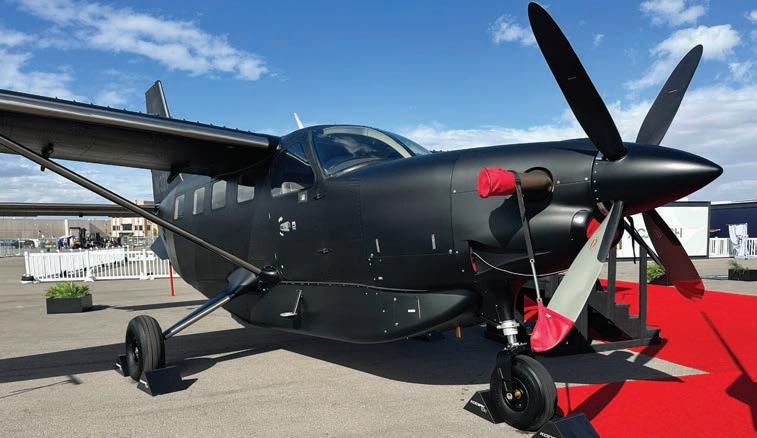
By Matt Thurber
Daher’s new operation in São Paulo will help it double sales of its TBM series and Kodiak turboprop singles in Brazil, according to Daher Aircraft CEO Nicolas Chabbert. The company currently sells about three airplanes a year in Brazil and expects this number to climb to six or seven.
“The TBM in this market makes total sense,” Chabbert said. “There is a huge country to cover, and the cost of operation, specifically of a jet, is making it a little bit complicated. The use of turboprops is something that is across Latin America very popular, and the TBM is no exception.
“If we look at the Kodiak, we already have airplanes that are flying [in the Amazonia region]. These aircraft are used for airlift for populations that are remote and need help. We believe that it’s an airplane that is going to work well with this environment in Brazil.”
The Brazil office is helmed by Paulo Cesar Olenscki, executive director, along with Rodrigo Cendon as customer relations director.
“The 10-seat Kodiak 100 and Kodiak 900… are perfectly tailored for the Brazilian market, offering modern, rugged, comfortable, and
simple-to-fly platforms that are flexible and sustainable,” according to the company, “while featuring easy convertibility to accommodate passengers, cargo, and mission systems. The large pallet-sized door facilitates the loading/ unloading of passengers, stretchers, and cargo.”
Meanwhile, Daher recently approved the design of its TBM and Kodiak manufacturing facility in Stuart, Florida. “We’ve selected the company that is going to build that,” Chabbert said, “and in the next few weeks, construction is going to get started.” Operations at that facility are set to begin in January 2027.
“The presence of Daher in America is very important,” he said. “As you know, we’re growing. This is a 40,000-people group today, and 10% of our employees are in the U.S. Our intention is truly to continue growing in the U.S.”
To ensure product support for the growing number of customers, Daher has added to its global support network for the TBM and Kodiak. Silver Sky Aviation in Wasilla, Alaska, is now a Kodiak service center. On the TBM side, North Carolina’s Victory Lane Aviation and Bloomington, Illinois-based Synergy Flight Center are recent additions.
“Expanding our customer support network and reinforcing its capacity are strategic
priorities as TBM and Kodiak fleets continue to grow,” Chabbert said. “By partnering with experienced service providers, we’re strengthening our ability to support U.S. operators where and when they need it.”
During a recent collaboration with the Recreational Aviation Foundation, Daher flew a Kodiak 100 to backcountry airstrips in the Pacific Northwest to support a U.S. Forest Service effort. The flights were staged from Moose Creek Ranger Station airstrip (1U1) and flew to Cayuse Creek (C64), Dixie (A05), Fish Lake (S92), Magee (S77), Orogrande (75C), and Wilson Bar (C48). These locations are critical access points for the Forest Service when it comes to firefighting, forest health monitoring, search and rescue, and recreational oversight. These flights underscored the utility of the Kodiak as a multi-mission aircraft. “There’s a lot of applications that we’re seeing with this aircraft,” Chabbert said. z
Signature Aviation is looking to improve the way its customers can find ramp space, hangars, and o ces at its airport locations with the launch of a web platform for aviation real estate. The new portal went live on the FBO group’s main website yesterday.
According to Signature, the portal allows existing and prospective tenants to search available options at its private aviation terminal locations. They can browse, filter, and initiate leasing inquiries in one place, taking into account requirements such as the space needed and hangar door heights.
Customers can access real-time details about real estate options at the group’s 200 properties in 27 countries, as well as photos.
Aircraft operators and other tenants also get access to Signature’s Resident Premier benefits program. C.A.
By Curt Epstein
Industry fuel provider Avfuel is once again on hand this week at NBAA-BACE 2025 to highlight its sustainability options. The Michigan-based company now provides consistent sustainable aviation fuel (SAF) supplies at 58 locations in the U.S., UK, and EU, providing more SAF to business aviation operations than any other fuel supplier.
Over the past year, Avfuel expanded its ISCC-certified SAF supply chain in the U.S. to now include distribution terminals in five states: Florida, New Jersey, Texas, Colorado, and California. Those terminals in turn feed retail locations in 14 states.
At its booth, the company is demonstrating its AvfuelZero sustainability platform, which launched two years ago and has expanded to include an online reporting capability and ISCC certification. This allows users to track and verify sustainability metrics through an internationally recognized system. AvfuelZero integrates emissions assessments, SAF, carbon offsetting, and reduction reporting into a single resource for measurable impact.
“AvfuelZero continues to grow as the most complete sustainability solution in business aviation offered by any fuel supply partner,” explained Keith Sawyer, Avfuel’s manager of alternative fuels. “It’s designed to make
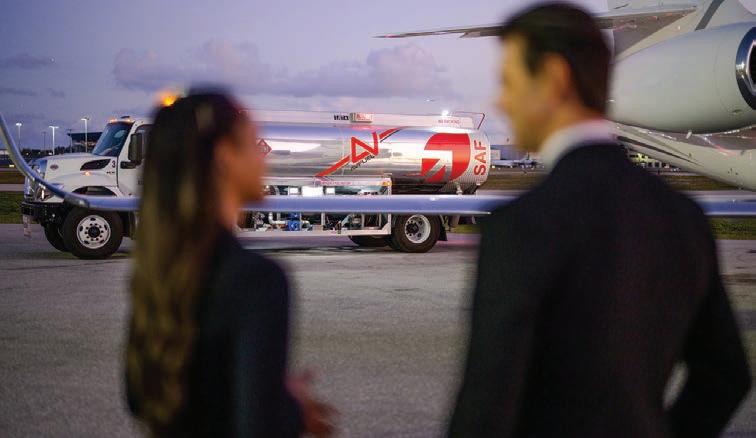
progress practical, helping our customers move from commitment to action.”
Sawyer discussed SAF during a panel yesterday as part of NBAA’s Business Aviation Sustainability Summit. Today, C.R. Sincock II, Avfuel’s executive v-p, will anchor a panel on “Preparing for the Sustainable Future: NextGen Infrastructure to Impact,” along with Joe Meszaros, v-p of operations at sister company Avflight; Eric Newman, Atlantic Aviation v-p of business development and sustainability; and Craig Teasdale, v-p of operations for Vertiports by Atlantic.
Beyond talking the sustainability talk, Avfuel is also walking the walk. In addition
Customers have the option to pay to offset the environmental impact of their flights.
to providing solutions to help operators in their decarbonization efforts, the company marks this year as its fifth consecutive year of offsetting its Scope 1 and 2 emissions, as well as its fourth year of certification under NATA’s Sustainability Standard for Aviation Businesses. It has maintained its Tier 2 Green Aviation Business certification for a second straight year and is the only fuel supplier to achieve that designation.
Exhibiting with Avfuel at this year’s NBAABACE are approximately 25 FBO members of its more than 700-strong branded dealer network, including some of its SAF distribution locations. z
George J. Priester Aviation is partnering with sustainability specialist 4Air with the aim of reducing emissions for aircraft operations. The companies announced their alliance on Tuesday at NBAA-BACE 2025, giving Priester’s aircraft management and charter clients the option to pay for carbon o sets and sustainable aviation fuel (SAF).
Priester is rolling out its use of 4Air’s various emissions mitigation measures. The group includes Priester Aviation, Mayo
Aviation, Hill Private Aviation, and Omni Private Aviation.
4Air arranges verified carbon o sets in units that correspond to a verified reduction or avoidance of one tonne of carbon dioxide. These support environmental projects that meet strict criteria and standards. The company is also looking to support access to SAF as the fuel becomes more widely available and helps companies with their carbon-reduction-compliance obligations.
According to 4Air, SAF is the most viable near-term solution to reducing emissions from aviation. In its neat form, it reduces the life cycle carbon footprint of aircraft fuel by up to 80% compared with jet-A.
“At George J. Priester, we believe that leadership in aviation means not only providing exceptional service, but also being responsible stewards of our environments,” said Madison Priester, the company’s director of marketing and sustainability. C.A.
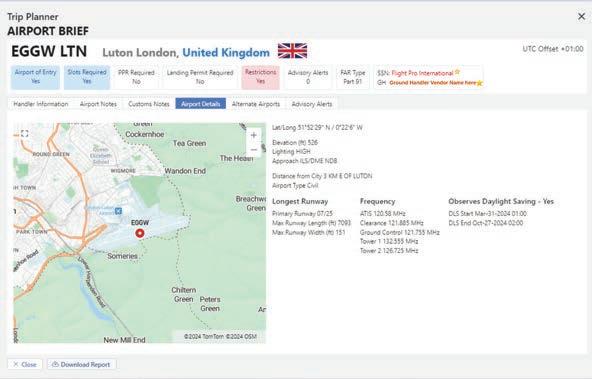
FlightPro’s Trip Planner provides flight crews with vital airport information in a single, easy-toread format.
By Amy Wilder
Flight Pro International (FPI) is marking its fifth anniversary with major updates to its cloud-based FlightProConnect platform, adding new user-convenience tools and expanded security features. The Houston-based company traces its roots to Air Routing International, which introduced services for VIP operators in the late 1970s before it was acquired in the early 2000s and reestablished as FPI in 2020.
Introduced at NBAA-BACE last year, the company’s Flight Pro Connect trip planner feature has evolved into what FPI president and COO Matt Pahl described as a powerful, real-time resource for operators. The latest version allows users to cross-compare airports worldwide, access preferred FBO and ground handling profiles, and view airport hours, customs procedures, and slot information.
What sets the software apart, according to Pahl, is that FPI filters massive amounts of global information so the customer doesn’t have to. “What we show them is what’s most relevant to their trip.” He explained that the operations team, supported by a network of global representatives and ground handlers, continuously updates airport and regulatory data through direct partnerships.
FPI’s meteorologists manage real-time flight planning and flight watch, while compliance specialists track regulatory changes worldwide. The company’s network of vendors offers options for ground services.
Recently added Trip Planner capabilities include the option to download multiple airport briefs in various formats, view satellite maps showing FBO locations and parking areas, and access up to two years of trip history. The software also now integrates real-time weather reports from The Weather Company, including metars, TAFs, and notams, enabling users to monitor operational conditions directly within the platform, which supports connectivity with global programs such as the EU’s ETIAS and EES systems.
Security upgrades have been another major focus. FlightProConnect now incorporates multi-factor authentication and encrypted offline visibility covering 48 hours of past trip data and 72 hours ahead.
Pahl underscored that timely, accurate data underpins every aspect of international trip support, and accurate information ensures that operators can make appropriate decisions.
Flight Pro’s goal remains to be the most trusted partner in international trip support, not necessarily the largest. “International trip support is a very intimate business,” Pahl concluded. z
Fledgling services provider Vantage Aviation is celebrating its one-year anniversary this week at NBAA-BACE 2025. The company’s cornerstone was laid last October with the purchase of Dominion Aviation, the lone FBO and aircraft charter provider at Richmond Executive-Chesterfield County Airport (KFCI) in Virginia.
Backed by private investment firm Jadian Capital, Vantage quickly followed that up by buying two FBOs in South Carolina and one in Minnesota in less than a month. It has a $33 million facility under construction at Colorado’s Rifle Garfield County Airport (KRIL), which is slated to open late next year, and the company is in line to acquire the assets of Corporate Air, one of two FBOs at Pittsburgh-area Allegheny County Airport (KAGC). Corporate Air recently declared bankruptcy.
Vantage revised its website not long ago, consolidating the information on its facilities with easy access to reservations, charter quotes, and airport development.
“It’s been an incredible year of growth, and we have far exceeded our own ambitious goals,” said company founder and CEO Ryan Maxfield. “As a fully integrated operator, we can provide a full menu of services to our customers, and I believe it is this value proposition that has assisted in our rapid expansion. We’re grateful for all of the support we’ve received throughout and can’t wait to see what the next 12 months has in store.” C.E.
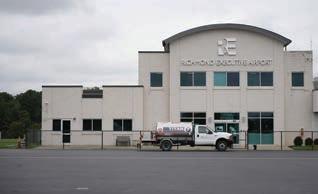

Jet Aviation added 22 jets to its U.S.based portfolio, including a pair of Gulfstream G700s. The company operates about 500 midsize and largecabin jets worldwide.
By Charles Alcock
Jet Aviation has expanded its U.S.-based aircraft management and charter portfolio with the addition of 22 jets, including a pair of Gulfstream G700s. Ten of these aircraft are available for charter under its Part 135 certificate, with the other 12 registered under its Part 91 and Part 125 certificates.
A mix of around 500 midsize and largecabin jets, ranging from long- to ultra-longrange, are included in the aircraft that Jet Aviation operates, with 200 based in the U.S. The company’s management services cover fueling, flight planning, maintenance, operational support, crew recruitment, and the option to offset costs by making the aircraft available to charter by third-party customers.
“We are proud to see continuous momentum in our managed fleet and charter offerings,” said David Dalpiaz, v-p of flight services in the Americas. “We are committed to providing our customers with fully tailored, comprehensive management services that meet their specific needs.”
The Jet Aviation group, which employs 4,500 people in 50 locations worldwide, is also expanding its staff recruitment service. Since launching the Staffing Marketplace in early 2023, the company has added about 45 enhancements, including face and touch ID for mobile iOS app users, improved ways for registering employment candidates, and enhanced document handling and notifications.
A digital portal, the Staffing Marketplace supports recruitment of specialist aviation personnel for full-time, part-time, and temporary roles. In March 2025, Jet Aviation integrated the service with the Avianis platform to streamline functions such as crew assignments, management, and administration. The service also covers contracts and payroll tasks.
“Jet Aviation Staffing Marketplace is a valuable tool for connecting operators and aviation professionals,” said Elaine Lapotsky, v-p of staffing.
“We are committed to advancing our comprehensive staffing portal to further empower business aviation professionals and operators alike. Our enhancements allow for more efficient usage, further refining the user experience.”
This week at NBAA-BACE 2025, Jet Aviation’s Staffing team can be found at the event’s Career Zone.
Jet Aviation is also marking the 40th anniversary of its FBO at Palm Beach International Airport (KPBI). The Florida facility now has six hangars, including a new structure alongside a Gulfstream maintenance facility that includes 42,000 sq ft of hangar and 200,000 sq ft of shared ramp space.
The company’s Palm Beach base employs 70 people and achieved fifth place in the Americas section of the 2025 AIN FBO Survey. The team there also supports Jet Aviation’s aircraft management and charter services and is one of the group’s 28 FBOs worldwide. In the next few weeks, Jet Aviation expects to open its latest FBO at Miami-Opa Locka Airport (KOPF).
“Over the past four decades, our Palm Beach facility has been a cornerstone in our U.S. network, supporting our commitment to being where our customers need us to be,” said David Best, senior v-p of regional operations Americas. z
FBO chain Modern Aviation launched a tenant loyalty program this week at NBAABACE 2025. Dubbed the Modern Aviation Tenancy Program: Welcome Home, the program is designed to enhance the experience of the company’s based aircraft customers at all 21 of its locations in the continental U.S. and Puerto Rico.
According to Modern, Welcome Home represents a “significant milestone” in its e ort to redefine what it means to be a tenant at a leading FBO chain. Across its entire network, it will o er based tenants a range of benefits tailored to their needs, including reduced facility fees, priority access to transient hangar space when available, and exclusive fuel pricing.

Favorable fuel pricing & reduced facility fees are some of the FBO chain’s enhancements.
“At Modern Aviation, we believe our tenants are more than just customers—they’re part of our family,” said CEO Mark Carmen. “The new tenant loyalty program is our way of showing appreciation and creating a more rewarding experience for those who choose to base with us.”
C.E.
When smoke enters the cockpit, pilots’ ability to see critical instruments and the outside environment can quickly vanish. Klatt Works created its Smoke Assured Vision Enhanced Display (SAVED) oxygen mask for these scenarios, and the company is spotlighting its progress this week at NBAA-BACE 2025.
The idea for SAVED traces back to the aftermath of UPS Flight 6 in 2010, when a Boeing 747 cargo fire filled the cockpit with dense smoke, overwhelming the crew and leading to a fatal crash near Dubai. FedEx sought solutions, and the concept of embedding augmented reality into oxygen masks emerged from that e ort. Founder and CEO Nate Klatt and his team carried the technology forward, and with FedEx as the cornerstone partner/customer, Klatt Works was born.
“NBAA is our biggest show,” Ron Gofron, director of sales and marketing for Klatt Works, told AIN. “We bring eight people with us, and we have our full podium with demo masks displaying the EVS and HUD information, just as pilots would see in the aircraft.”
continued from page 1
Another differentiator, according to Bond, is that every flight will have a flight attendant on board.
“We are not building for scale. We are building for the select few who expect service perfection every time they fly,” Papariella said.
Features of the Bond program include a limit of 10 owners per aircraft, which the company said is the lowest of any fractional provider; an exclusive fleet reserved only for fractional owners with no access to jet cards or charter; increased standby capacity with reserved aircraft pre-positioned to cover peak customer demand; evergreen membership with “an intelligent capital efficient design;” and “the highest-paid and most experienced pilots.”
As for the selection of the Bombardier jets, Papariella added, “Our relationship with [Bombardier’s] team spans many years through my previous work in the aftermarket space at Jet Edge, and I’ve seen firsthand the culture, consistency, and service mindset

The SAVED system combines a high-resolution, low-latency display with a feed from the aircraft’s external camera (EVS or EFVS system) and HUD symbology generator. The concentrator unit overlays camera imagery with flight data and projects it onto miniature displays embedded in the oxygen mask. For the pilot, the result is a full view of attitude, altitude, airspeed, and outside terrain, even if smoke obscures the windscreen and instrument panel.
Progress is accelerating in the business aviation sector, with several business jet STCs nearing completion. Cargo aircraft remain a major focus for the technology. A.W.
JAMES HOLAHAN (1921-2015), FOUNDING EDITOR
WILSON S. LEACH, FOUNDER & CHAIR EMERITUS
EDITOR-IN-CHIEF – Matt Thurber
MANAGING EDITOR – Charles Alcock
PRESS ROOM EDITOR – Chad Trautvetter
PRESS ROOM MANAGING EDITOR – Jessica Reed
THE EDITORIAL TEAM - Charlotte Bailey, Curt Epstein, Kerry Lynch, Hanneke Weitering, Amy Wilder
PRODUCTION MANAGER – Martha Jercinovich
GRAPHIC DESIGNERS – Grzegorz Rzekos
PHOTOGRAPHERS – Barry Ambrose, Mariano Rosales
DIRECTOR OF VIDEO – Ian Whelan
EXECUTIVE CHAIR – Dave Leach
PRESIDENT – Ruben Kempeneer
HEAD OF PEOPLE & BRAND – Jennifer Leach English
SENIOR DIRECTOR EVENTS – Nancy O’Brien
ADVERTISING SALES
DIRECTOR OF SALES - Henry Specht
Victoria Tod – Northeastern U.S./Eastern Canada/United Kingdom, +1 (203) 733-4184
Michelle James – Western U.S./Western Canada, +1 (520) 343-0236
Joe Rosone – Midwestern U.S., Southeastern U.S./Caribbean/ Brazil, +1 (301) 693-4687
Diana Scogna – Europe/Middle East, +33 6 62 52 25 47
DIRECTOR MARKETING AND CLIENT SERVICES – Lisa Valladares
AUDIENCE DEVELOPMENT DIRECTOR – Eileen Silberfeld
SOCIAL MEDIA MARKETING – Zach O’Brien
that make Bombardier exceptional. This relationship isn’t simply about aircraft—it’s about shared values and a long-term commitment to redefining reliability and care in private aviation.”
Speaking to reporters yesterday, he added, “I think we likely pulled off the fastest deal in the history of aviation and capital markets for buying a fleet. The vision was not just to create another fractional program. I think we can all agree that the demand for fractional over the last cycle speaks for itself. It’s been dominated by a number of individuals who have done an absolutely phenomenal job perfecting that model.”
For KKR, this continues an ongoing relationship it has had with Papariella, previously providing multiple rounds of financing for Jet Edge, which was ultimately sold to Vista. In addition, KKR has acquired Atlantic Aviation and led financing for Greenbriar Equity Group’s acquisition of West Star Aviation. z
SALES ADMINISTRATOR – Cindy Nesline
MANAGER OF FINANCE & HUMAN RESOURCES – Tracy Britton
ACCOUNTS PAYABLE – Mary Avella
ACCOUNTS RECEIVABLE – Bobbie Bing
U.S. HEADQUARTERS:
214 Franklin Ave., Midland Park, NJ 07432, +1 (201) 444-5075
Advertising Inquiries: +1 (201) 345-0085, adsales@ainonline.com
Circulation Inquiries: +1 (201) 345-0085, subscriptions@ainonline.com
WASHINGTON, D.C. EDITORIAL OFFICE: Kerry Lynch (business aviation) – klynch@ainonline.com +1 (703) 969-9195
EUROPEAN EDITORIAL OFFICE: Charles Alcock – calcock@ainonline.com, Tel: +44 7799 907595
NBAA Convention News is a publication of the AIN Media Group, Inc., 214 Franklin Ave., Midland Park, NJ 07432; Tel.: +1 (201) 444-5075. Copyright © 2025 All rights reserved. Reproduction in whole or in part without permission of AIN Media Group, Inc. is strictly prohibited. AIN Media Group, Inc. publishes Aviation International News, AINalerts, Business Jet Traveler,
Save time and money by monitoring the value of your aircraft in 'real-time'.

Subscribers can also:
– Generate a comprehensive list of all aircraft transactions in the last 12 months
– View a detailed photo gallery for your specific aircraft
– Receive a weekly report summarizing market fluctuations

Every second. Every minute. Every hour. Every day.
We make 4,000 experts available to our clients 24/7/365 across our worldwide support network.

Supervisor


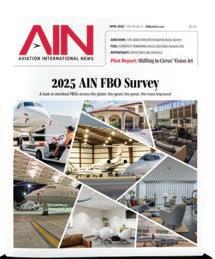

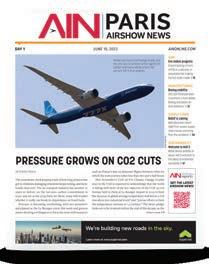




Every second. Every minute. Every hour. Every day.
We make 4,000 experts available to our clients 24/7/365 across our worldwide support network.

Supervisor
